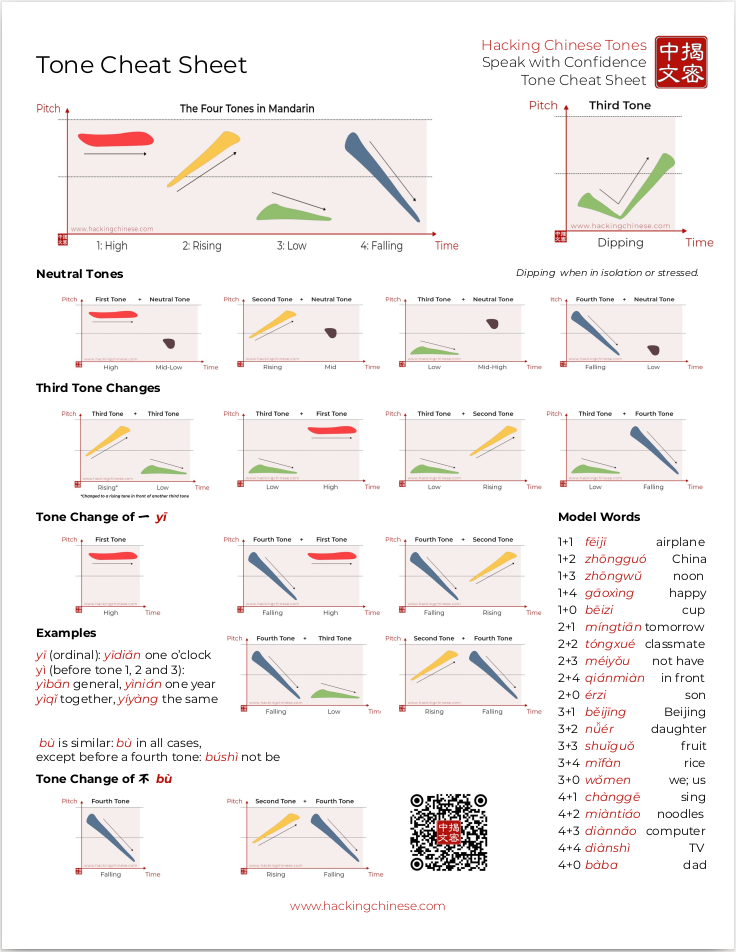 Tones are, without doubt, one of the hardest parts of Chinese to master, and many students struggle with them even long after leaving the beginner stage of learning.
Tones are, without doubt, one of the hardest parts of Chinese to master, and many students struggle with them even long after leaving the beginner stage of learning.
Understanding the basics of tones in Chinese isn’t that hard and most people can do it relatively quickly with the right kind of instruction and some practice, but it’s not easy to translate this knowledge into actual speaking ability.
I make tone mistakes occasionally myself, even though I have studied Chinese for more than a decade, but I’m pretty good at spotting them and repairing my own utterances.
I believe that mastering tone pairs is crucial for all students. In this article, I will do two things:
- I will explain why tone pairs are so useful.
- I will give you more tone combinations that you can possibly wish in the form of tone sorted HSK and TOCFL vocabulary lists.
I will do this both in text and through a podcast episode with content from my pronunciation course:
Tune in to the Hacking Chinese Podcast to listen to the related episode:
Available on Apple Podcasts, Google Podcasts, Overcast, Spotify, YouTube and many other platforms!
There’s also a sneak peek at the relevant lesson in my pronunciation course:
If you want to skip my explanations and just get to the words, either scroll down or skip directly to the HSK and TOCFL lists or to the bottom of the article where I list the top 50 words for each combination.
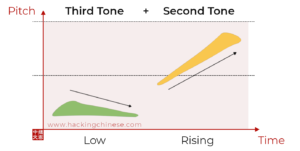 Why tone pairs?
Why tone pairs?
One problem with the way tones are normally taught is that way too much time is spent on single-syllable words.
This becomes an even bigger problem if the third tone is taught as a full falling-rising tone, which will lead to problems because that’s not the way it’s normally pronounced.
Therefore, the best way of practising tones in Chinese is to move to words consisting of two syllables as soon as possible.
Naturally, you can also practice sentences and intonation, but that’s something different and if you find tones are hard to grasp in the first place, reading a long sentence and superimposing intonation certainly won’t make things easier.
Mastering tone pairs is a must!
Practising Chinese tones in pairs
The reason disyllabic words are great is that most tone change (sandhi) rules apply, but a single word is still short enough to be focused on properly. It also makes sense to focus on these words because modern Mandarin has a very strong preference for disyllabic words, meaning that if you know all possible combinations really well, getting pronunciation in sentences right is mostly a matter of practise.
What I mean by this is that if you don’t get the basic two-syllable combinations, you might not learn to produce correct sentences at all, regardless of how much you practise. If you do learn how to handle disyllabic words, you will probably be able to produce good sentences simply by paying attention and speaking more Chinese since you already have the basics down.
Another thing to remember is that your tones might not be as good as you think. I think all students should try doing a blind test at least once, meaning that the listener doesn’t know or guess the right answer and can’t pretend to understand.
You will most likely find that there are problems you weren’t aware of, even if you’ve studied Chinese for a while (some problems are really hard to spot without feedback). You can use my tone bingo game for this, which is very good at catching pronunciation problems and is quite fun as well.
More tone pairs for learning and teaching
Both when learning and teaching tones, it’s useful to have a very large number of examples and to find examples that are already known words. My good friend Magnus Falk helped me to write a script that sorts word lists based on tones.
It actually turned out to take longer than he thought, but we now have a script that works fairly well. If you’re a developer yourself, all necessary files are available on GitHub (the tone sorter is written in Python).
If you just want more tone combinations than you’ll ever need, just keep on reading!
1,000 tone pairs, sorted by HSK or TOCFL level
First, I offer the complete lists for both HSK (simplified) and TOCFL (traditional), sorted by tone combination. You can download the lists here:
- The entire HSK list (simplified) as a CSV text file
- The entire HSK list (simplified) as an Excel file
- The entire TOCFL list (traditional) as a CSV text file
- The entire TOCFL list (traditional) as an Excel file
The lists contain words with more than two syllables as well, so if you want to practise three-syllable words, you just need to download the files. The polysyllabic words are of course also sorted by tone! The list also contains monosyllables, but mostly for the sake of comprehensiveness.
Second, I provide 1,000 tone pairs for quick reference below, including HSK level, Chinese characters and Pinyin. If you use the quick links to each section, you can hit “back” in your browser to get back to the index.
Hacking Chinese Pronunciation: Speaking with Confidence
My hope is that you find this article helpful. If you want to learn more about Mandarin pronunciation, including tones, check out my pronunciation video course. It covers everything you need to know to speak clearly and with confidence!
Hacking Chinese Pronunciation: Speaking with Confidence
T2 + T?
T3 + T?
T4 + T?
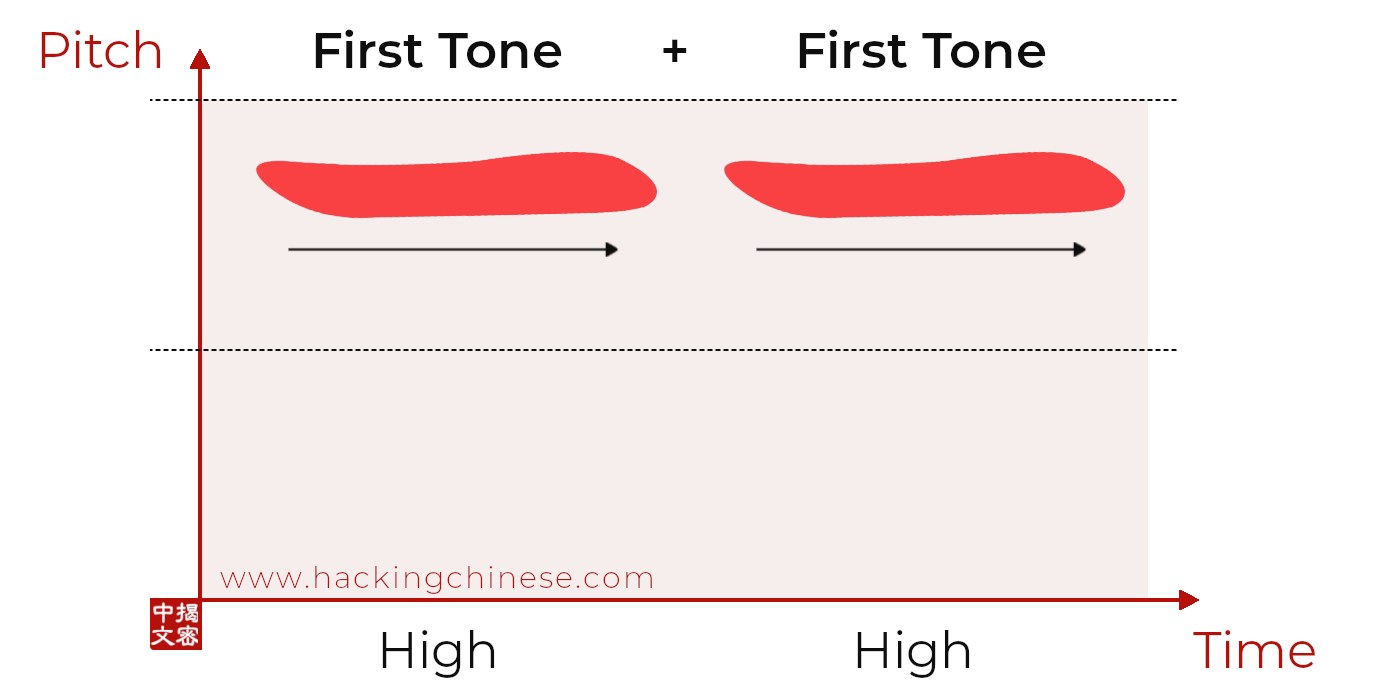 First tone + First tone
First tone + First tone
| HSK | Word | Pinyin |
| 1 | 飞机 | fēijī |
| 1 | 分钟 | fēnzhōng |
| 1 | 今天 | jīntiān |
| 1 | 星期 | xīngqī |
| 1 | 医生 | yīshēng |
| 2 | 公司 | gōngsī |
| 2 | 咖啡 | kāfēi |
| 2 | 西瓜 | xīguā |
| 3 | 冰箱 | bīngxiāng |
| 3 | 参加 | cānjiā |
| 3 | 担心 | dānxīn |
| 3 | 发烧 | fāshāo |
| 3 | 公斤 | gōngjīn |
| 3 | 刮风 | guāfēng |
| 3 | 关心 | guānxīn |
| 3 | 几乎 | jīhū |
| 3 | 声音 | shēngyīn |
| 3 | 司机 | sījī |
| 3 | 香蕉 | xiāngjiāo |
| 3 | 新鲜 | xīnxiān |
| 3 | 应该 | yīnggāi |
| 3 | 中间 | zhōngjiān |
| 4 | 餐厅 | cāntīng |
| 4 | 参观 | cānguān |
| 4 | 吃惊 | chī jīng |
| 4 | 抽烟 | chōuyān |
| 4 | 出差 | chū chāi |
| 4 | 出发 | chūfā |
| 4 | 出生 | chūshēng |
| 4 | 粗心 | cūxīn |
| 4 | 发生 | fāshēng |
| 4 | 干杯 | gān bēi |
| 4 | 工资 | gōngzī |
| 4 | 加班 | jiā bān |
| 4 | 交通 | jiāotōng |
| 4 | 郊区 | jiāoqū |
| 4 | 开心 | kāixīn |
| 4 | 轻松 | qīngsōng |
| 4 | 沙发 | shāfā |
| 4 | 伤心 | shāngxīn |
| 4 | 稍微 | shāowēi |
| 4 | 通知 | tōngzhī |
| 4 | 增加 | zēngjiā |
| 5 | 安装 | ānzhuāng |
| 5 | 悲观 | bēiguān |
| 5 | 操心 | cāo xīn |
| 5 | 车厢 | chēxiāng |
| 5 | 吃亏 | chīkuī |
| 5 | 粗糙 | cūcāo |
| 5 | 当心 | dāngxīn |
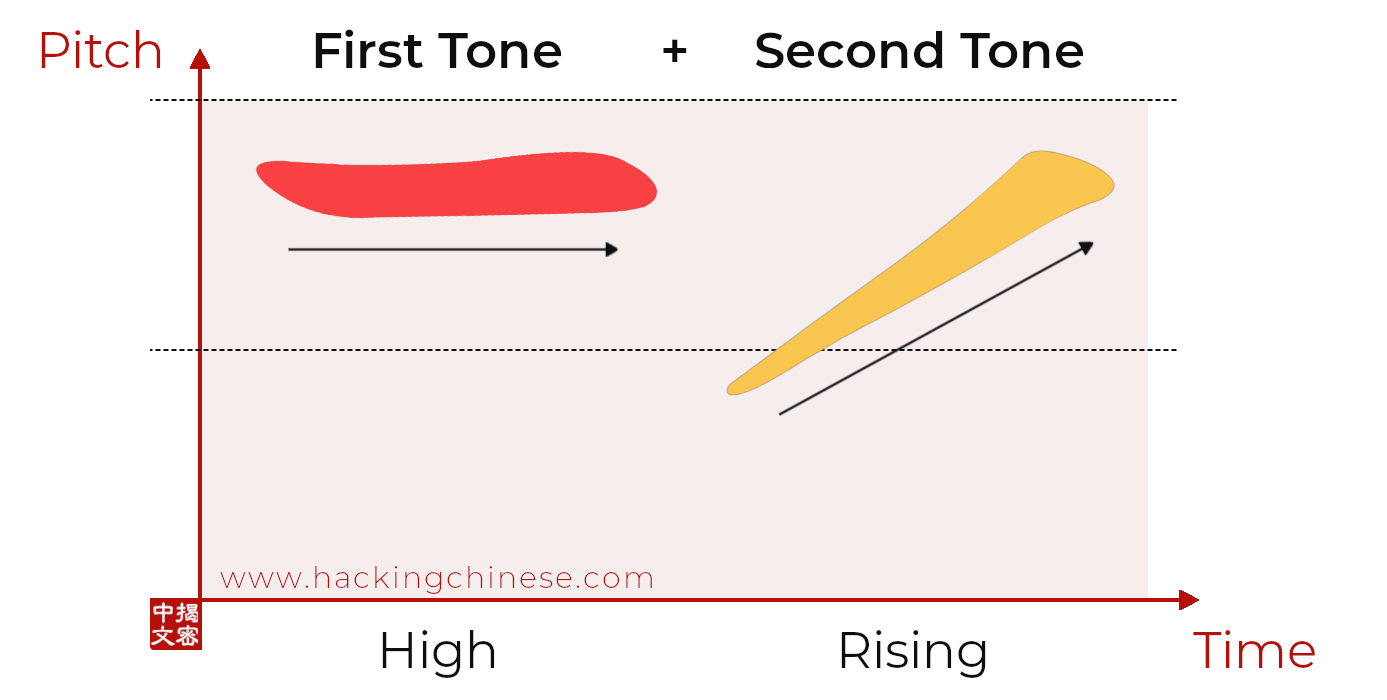 First tone + Second tone
First tone + Second tone
| HSK | Word | Pinyin |
| 1 | 中国 | zhōngguó |
| 2 | 非常 | fēicháng |
| 2 | 虽然 | suīrán |
| 3 | 阿姨 | āyí |
| 3 | 帮忙 | bāngmáng |
| 3 | 当然 | dāngrán |
| 3 | 刚才 | gāngcái |
| 3 | 公园 | gōngyuán |
| 3 | 关于 | guānyú |
| 3 | 欢迎 | huānyíng |
| 3 | 经常 | jīngcháng |
| 3 | 空调 | kōngtiáo |
| 3 | 刷牙 | shuāyá |
| 3 | 突然 | tūrán |
| 3 | 新闻 | xīnwén |
| 3 | 要求 | yāoqiú |
| 3 | 中文 | zhōngwén |
| 3 | 终于 | zhōngyú |
| 4 | 安排 | ānpái |
| 4 | 安全 | ānquán |
| 4 | 当时 | dāngshí |
| 4 | 积极 | jījí |
| 4 | 坚持 | jiānchí |
| 4 | 将来 | jiānglái |
| 4 | 交流 | jiāoliú |
| 4 | 科学 | kēxué |
| 4 | 批评 | pīpíng |
| 4 | 区别 | qūbié |
| 4 | 森林 | sēnlín |
| 4 | 生活 | shēnghuó |
| 4 | 说明 | shuōmíng |
| 4 | 推迟 | tuīchí |
| 4 | 相同 | xiāngtóng |
| 4 | 心情 | xīnqíng |
| 4 | 支持 | zhīchí |
| 4 | 周围 | zhōuwéi |
| 4 | 专门 | zhuānmén |
| 5 | 包含 | bāohán |
| 5 | 编辑 | biānjí |
| 5 | 超级 | chāojí |
| 5 | 出席 | chūxí |
| 5 | 初级 | chūjí |
| 5 | 窗帘 | chuānglián |
| 5 | 匆忙 | cōngmáng |
| 5 | 单纯 | dānchún |
| 5 | 单独 | dāndú |
| 5 | 单元 | dānyuán |
| 5 | 多余 | duōyú |
| 5 | 发愁 | fā chóu |
| 5 | 发达 | fādá |
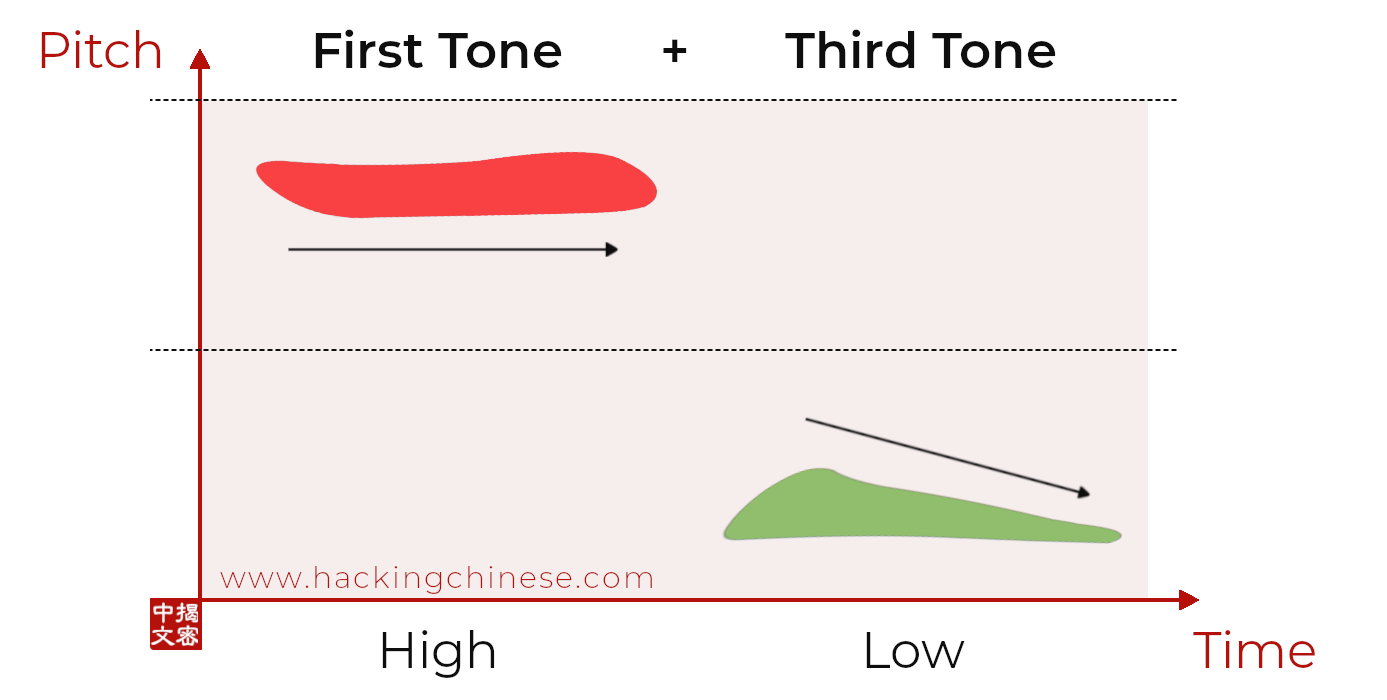 First tone + Third tone
First tone + Third tone
| HSK | Word | Pinyin |
| 1 | 中午 | zhōngwǔ |
| 2 | 宾馆 | bīnguǎn |
| 2 | 机场 | jīchǎng |
| 2 | 开始 | kāishǐ |
| 2 | 铅笔 | qiānbǐ |
| 2 | 身体 | shēntǐ |
| 3 | 黑板 | hēibǎn |
| 3 | 经理 | jīnglǐ |
| 4 | 标准 | biāozhǔn |
| 4 | 发展 | fāzhǎn |
| 4 | 方法 | fāngfǎ |
| 4 | 公里 | gōnglǐ |
| 4 | 积累 | jīlěi |
| 4 | 基础 | jīchǔ |
| 4 | 精彩 | jīngcǎi |
| 4 | 缺点 | quēdiǎn |
| 4 | 缺少 | quēshǎo |
| 4 | 申请 | shēnqǐng |
| 4 | 危险 | wēixiǎn |
| 4 | 污染 | wūrǎn |
| 4 | 吸引 | xīyǐn |
| 4 | 相反 | xiāngfǎn |
| 4 | 辛苦 | xīnkǔ |
| 4 | 修理 | xiūlǐ |
| 4 | 邀请 | yāoqǐng |
| 4 | 因此 | yīncǐ |
| 4 | 优点 | yōudiǎn |
| 5 | 包裹 | bāoguǒ |
| 5 | 标点 | biāodiǎn |
| 5 | 参考 | cānkǎo |
| 5 | 操场 | cāochǎng |
| 5 | 充满 | chōngmǎn |
| 5 | 出版 | chūbǎn |
| 5 | 出口 | chūkǒu |
| 5 | 发表 | fābiǎo |
| 5 | 发抖 | fādǒu |
| 5 | 分手 | fēnshǒu |
| 5 | 风景 | fēngjǐng |
| 5 | 风险 | fēngxiǎn |
| 5 | 钢铁 | gāngtiě |
| 5 | 根本 | gēnběn |
| 5 | 工厂 | gōngchǎng |
| 5 | 公主 | gōngzhǔ |
| 5 | 恭喜 | gōngxǐ |
| 5 | 观点 | guāndiǎn |
| 5 | 婚礼 | hūnlǐ |
| 5 | 基本 | jīběn |
| 5 | 肩膀 | jiānbǎng |
| 5 | 艰苦 | jiānkǔ |
| 5 | 交往 | jiāowǎng |
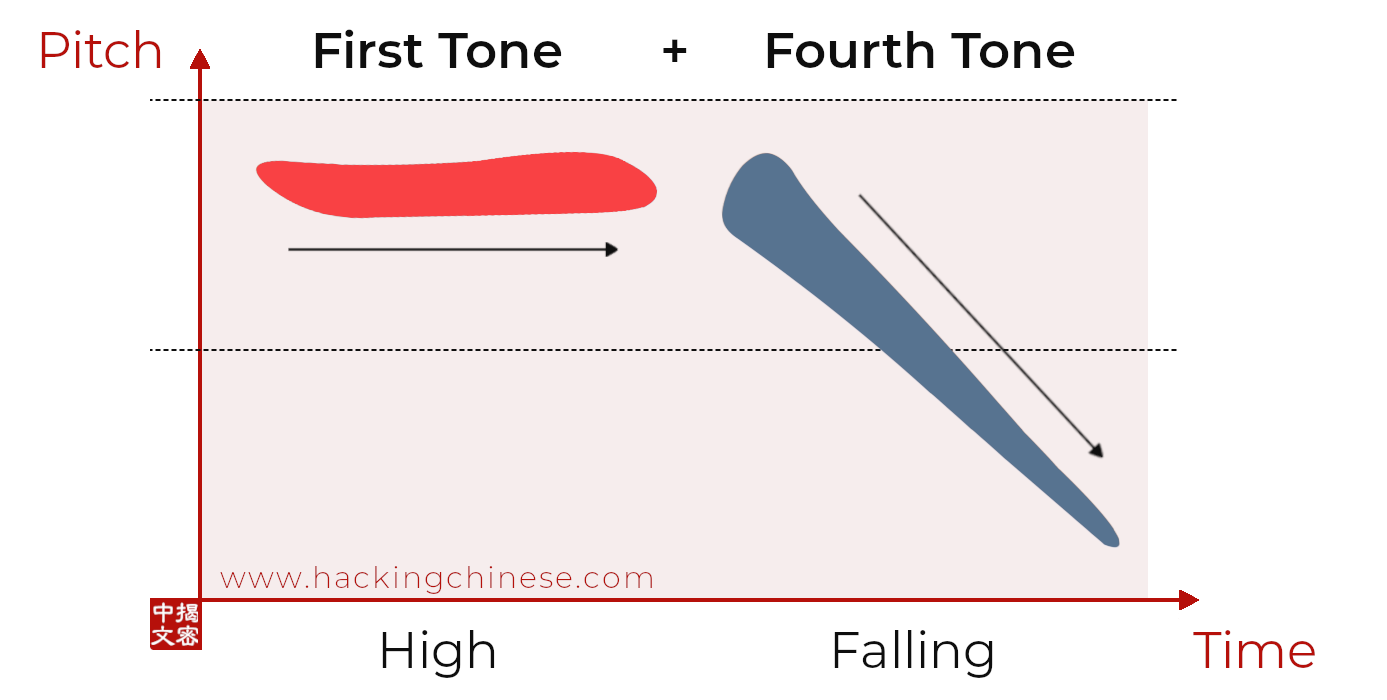 First tone + Fourth tone
First tone + Fourth tone
| HSK | Word | Pinyin |
| 1 | 高兴 | gāoxìng |
| 1 | 工作 | gōngzuò |
| 1 | 商店 | shāngdiàn |
| 1 | 天气 | tiānqì |
| 1 | 医院 | yīyuàn |
| 2 | 帮助 | bāngzhù |
| 2 | 鸡蛋 | jīdàn |
| 2 | 生病 | shēngbìng |
| 2 | 生日 | shēngrì |
| 2 | 说话 | shuōhuà |
| 2 | 希望 | xīwàng |
| 2 | 因为 | yīnwèi |
| 3 | 安静 | ānjìng |
| 3 | 超市 | chāoshì |
| 3 | 发现 | fāxiàn |
| 3 | 方便 | fāngbiàn |
| 3 | 干净 | gānjìng |
| 3 | 根据 | gēnjù |
| 3 | 机会 | jīhuì |
| 3 | 街道 | jiēdào |
| 3 | 经过 | jīngguò |
| 3 | 生气 | shēngqì |
| 3 | 相信 | xiāngxìn |
| 3 | 需要 | xūyào |
| 3 | 音乐 | yīnyuè |
| 3 | 周末 | zhōumò |
| 4 | 超过 | chāoguò |
| 4 | 出现 | chūxiàn |
| 4 | 翻译 | fānyì |
| 4 | 方面 | fāngmiàn |
| 4 | 方向 | fāngxiàng |
| 4 | 丰富 | fēngfù |
| 4 | 估计 | gūjì |
| 4 | 关键 | guānjiàn |
| 4 | 观众 | guānzhòng |
| 4 | 规定 | guīdìng |
| 4 | 激动 | jīdòng |
| 4 | 家具 | jiājù |
| 4 | 骄傲 | jiāo’ào |
| 4 | 接受 | jiēshòu |
| 4 | 京剧 | jīngjù |
| 4 | 经济 | jīngjì |
| 4 | 经历 | jīnglì |
| 4 | 经验 | jīngyàn |
| 4 | 究竟 | jiūjìng |
| 4 | 空气 | kōngqì |
| 4 | 千万 | qiānwàn |
| 4 | 签证 | qiānzhèng |
| 4 | 生命 | shēngmìng |
| 4 | 失败 | shībài |
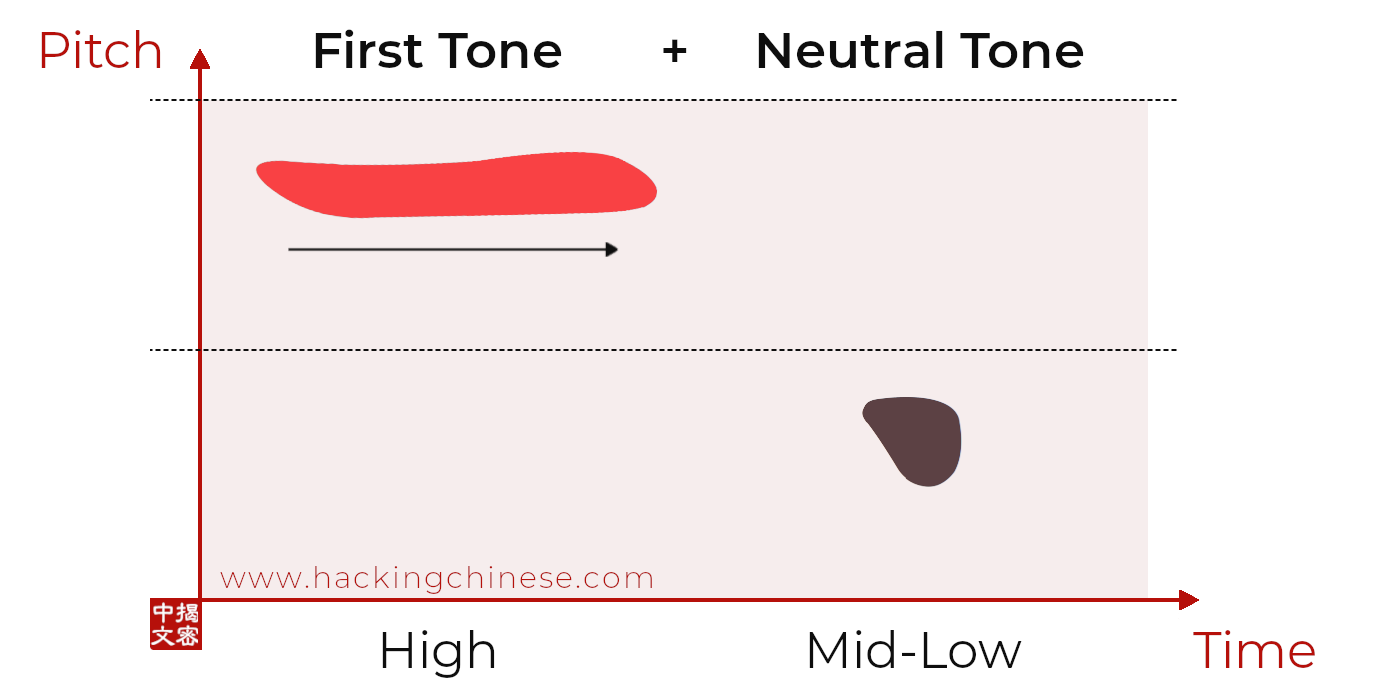 First tone + Neutral tone
First tone + Neutral tone
| HSK | Word | Pinyin |
| 1 | 杯子 | bēizi |
| 1 | 东西 | dōngxi |
| 1 | 多少 | duōshao |
| 1 | 妈妈 | māma |
| 1 | 先生 | xiānsheng |
| 1 | 衣服 | yīfu |
| 1 | 桌子 | zhuōzi |
| 2 | 哥哥 | gēge |
| 2 | 妻子 | qīzi |
| 2 | 休息 | xiūxi |
| 2 | 知道 | zhīdao |
| 3 | 聪明 | cōngming |
| 3 | 多么 | duōme |
| 3 | 关系 | guānxi |
| 3 | 清楚 | qīngchu |
| 3 | 叔叔 | shūshu |
| 3 | 舒服 | shūfu |
| 4 | 包子 | bāozi |
| 4 | 窗户 | chuānghu |
| 4 | 胳膊 | gēbo |
| 4 | 功夫 | gōngfu |
| 4 | 接着 | jiēzhe |
| 4 | 亲戚 | qīnqi |
| 4 | 商量 | shāngliang |
| 4 | 生意 | shēngyi |
| 4 | 师傅 | shīfu |
| 4 | 收拾 | shōushi |
| 4 | 孙子 | sūnzi |
| 4 | 消息 | xiāoxi |
| 4 | 知识 | zhīshi |
| 5 | 玻璃 | bōli |
| 5 | 叉子 | chāzi |
| 5 | 称呼 | chēnghu |
| 5 | 抽屉 | chōuti |
| 5 | 答应 | dāying |
| 5 | 耽误 | dānwu |
| 5 | 姑姑 | gūgu |
| 5 | 规矩 | guīju |
| 5 | 姑娘 | gūniang |
| 5 | 夹子 | jiāzi |
| 5 | 结实 | jiēshi |
| 5 | 精神 | jīngshen |
| 5 | 狮子 | shīzi |
| 5 | 梳子 | shūzi |
| 5 | 屋子 | wūzi |
| 6 | 报酬 | bàochou |
| 6 | 报复 | bàofu |
| 6 | 辫子 | biànzi |
| 6 | 别扭 | bièniu |
| 6 | 伺候 | cìhou |
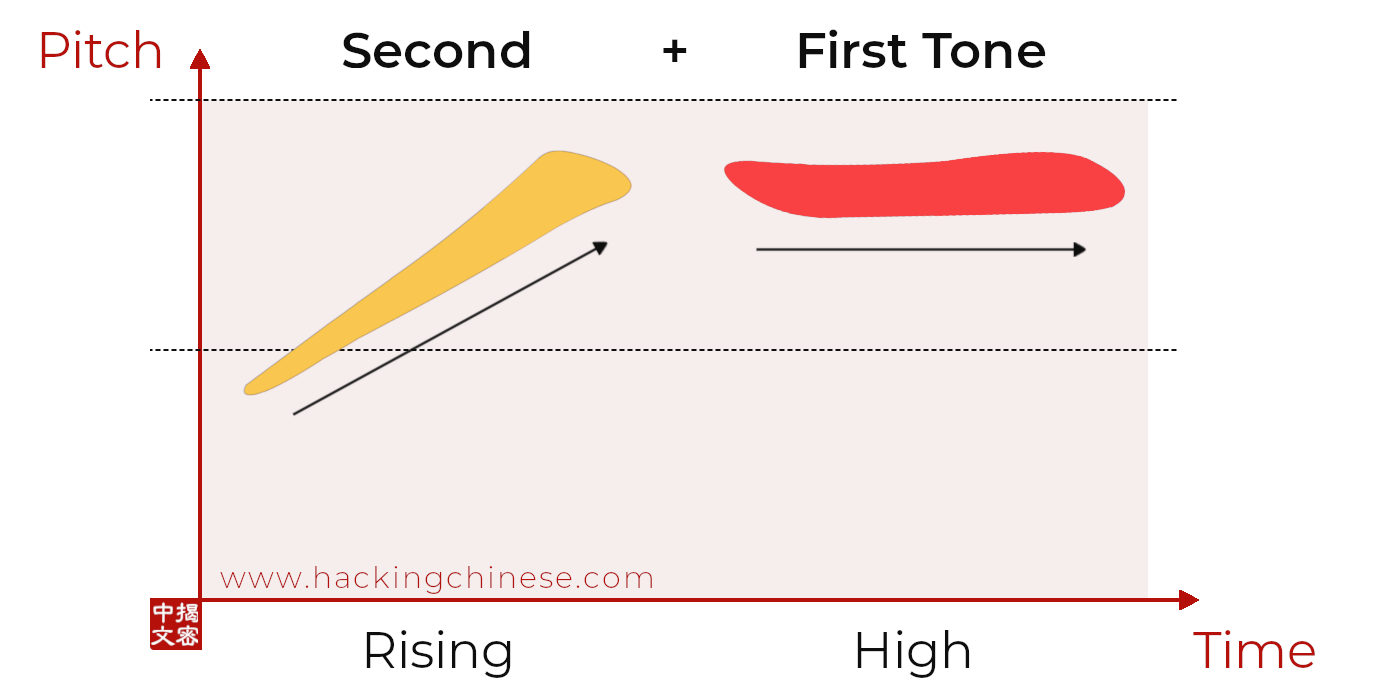 Second tone + First tone
Second tone + First tone
| HSK | Word | Pinyin |
| 1 | 明天 | míngtiān |
| 1 | 昨天 | zuótiān |
| 2 | 房间 | fángjiān |
| 2 | 旁边 | pángbiān |
| 2 | 时间 | shíjiān |
| 3 | 国家 | guójiā |
| 3 | 结婚 | jiéhūn |
| 3 | 离开 | líkāi |
| 3 | 聊天 | liáotiān |
| 3 | 邻居 | línjū |
| 3 | 年轻 | niánqīng |
| 3 | 爬山 | páshān |
| 3 | 其他 | qítā |
| 3 | 提高 | tígāo |
| 3 | 熊猫 | xióngmāo |
| 4 | 长江 | chángjiāng |
| 4 | 成功 | chénggōng |
| 4 | 重新 | chóngxīn |
| 4 | 传真 | chuánzhēn |
| 4 | 房东 | fángdōng |
| 4 | 航班 | hángbān |
| 4 | 节约 | jiéyuē |
| 4 | 毛巾 | máojīn |
| 4 | 皮肤 | pífū |
| 4 | 其中 | qízhōng |
| 4 | 十分 | shífēn |
| 4 | 熟悉 | shúxī |
| 4 | 提供 | tígōng |
| 4 | 文章 | wénzhāng |
| 4 | 学期 | xuéqī |
| 4 | 牙膏 | yágāo |
| 4 | 研究 | yánjiū |
| 4 | 阳光 | yángguāng |
| 4 | 原因 | yuányīn |
| 4 | 直接 | zhíjiē |
| 5 | 曾经 | céngjīng |
| 5 | 潮湿 | cháoshī |
| 5 | 承担 | chéngdān |
| 5 | 除非 | chúfēi |
| 5 | 除夕 | chúxī |
| 5 | 传播 | chuánbō |
| 5 | 传说 | chuánshuō |
| 5 | 服装 | fúzhuāng |
| 5 | 核心 | héxīn |
| 5 | 胡说 | húshuō |
| 5 | 黄金 | huángjīn |
| 5 | 集中 | jízhōng |
| 5 | 决心 | juéxīn |
| 5 | 离婚 | lí hūn |
| 5 | 明星 | míngxīng |
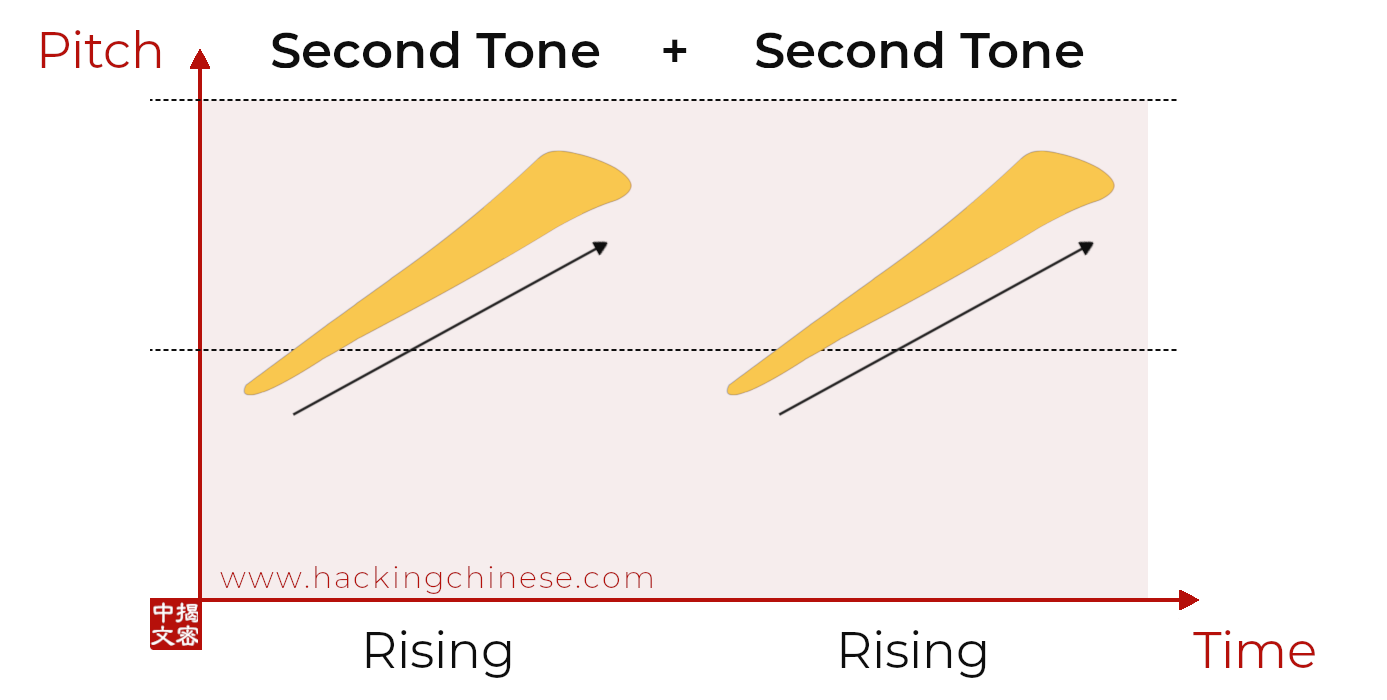 Second tone + Second tone
Second tone + Second tone
| HSK | Word | Pinyin |
| 1 | 同学 | tóngxué |
| 1 | 学习 | xuéxí |
| 3 | 黄河 | huánghé |
| 3 | 回答 | huídá |
| 3 | 留学 | liúxué |
| 3 | 年级 | niánjí |
| 3 | 皮鞋 | píxié |
| 3 | 其实 | qíshí |
| 3 | 完成 | wánchéng |
| 3 | 银行 | yínháng |
| 3 | 着急 | zháojí |
| 4 | 长城 | chángchéng |
| 4 | 成为 | chéngwéi |
| 4 | 诚实 | chéngshí |
| 4 | 厨房 | chúfáng |
| 4 | 从来 | cónglái |
| 4 | 儿童 | értóng |
| 4 | 符合 | fúhé |
| 4 | 国籍 | guójí |
| 4 | 合格 | hégé |
| 4 | 怀疑 | huáiyí |
| 4 | 及时 | jíshí |
| 4 | 零钱 | língqián |
| 4 | 流行 | liúxíng |
| 4 | 民族 | mínzú |
| 4 | 年龄 | niánlíng |
| 4 | 平时 | píngshí |
| 4 | 然而 | rán’ér |
| 4 | 仍然 | réngrán |
| 4 | 提前 | tíqián |
| 4 | 同情 | tóngqíng |
| 4 | 同时 | tóngshí |
| 4 | 完全 | wánquán |
| 4 | 无聊 | wúliáo |
| 4 | 严格 | yángé |
| 4 | 尤其 | yóuqí |
| 4 | 由于 | yóuyú |
| 4 | 邮局 | yóujú |
| 4 | 原来 | yuánlái |
| 5 | 长途 | chángtú |
| 5 | 常识 | chángshí |
| 5 | 成人 | chéngrén |
| 5 | 成熟 | chéngshú |
| 5 | 池塘 | chítáng |
| 5 | 辞职 | cízhí |
| 5 | 从而 | cóng’ér |
| 5 | 从前 | cóngqián |
| 5 | 敌人 | dírén |
| 5 | 繁荣 | fánróng |
| 5 | 国王 | guówáng |
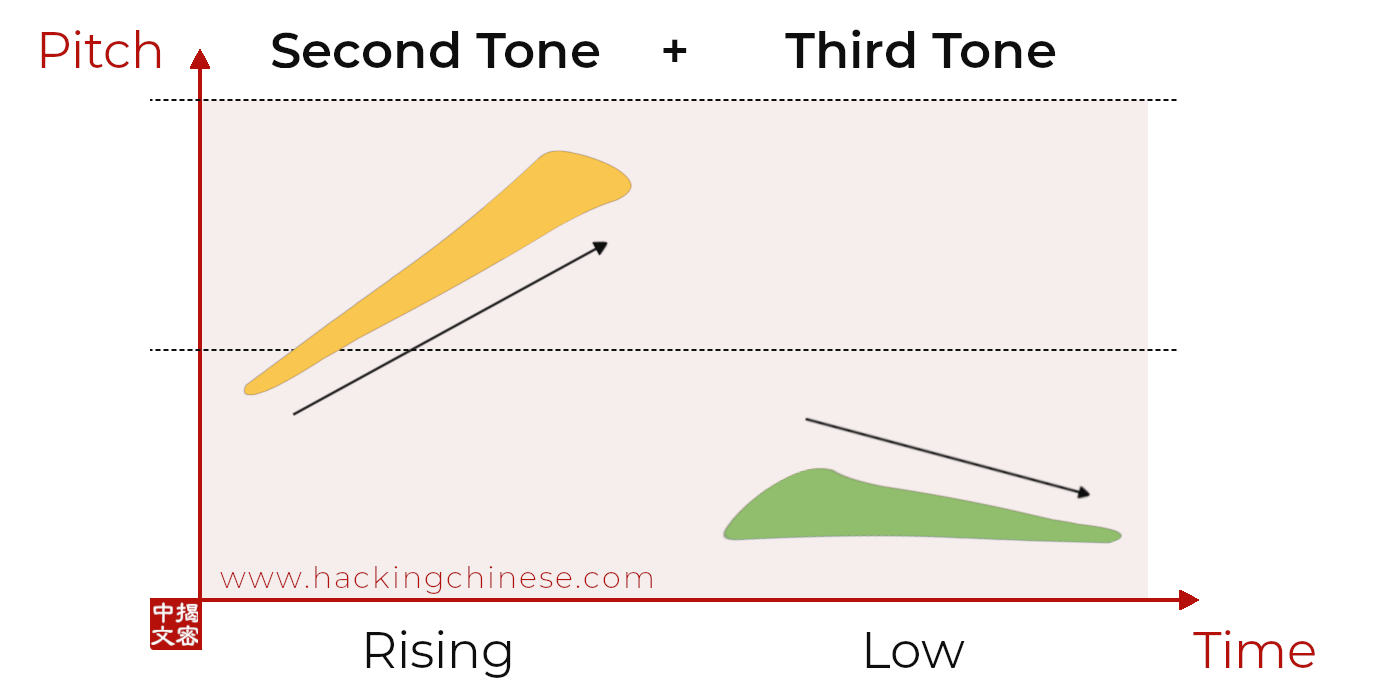 Second tone + Third tone
Second tone + Third tone
| HSK | Word | Pinyin |
| 1 | 没有 | méiyǒu |
| 1 | 苹果 | píngguǒ |
| 2 | 牛奶 | niúnǎi |
| 2 | 游泳 | yóuyǒng |
| 3 | 词典 | cídiǎn |
| 3 | 而且 | érqiě |
| 3 | 啤酒 | píjiǔ |
| 3 | 如果 | rúguǒ |
| 4 | 词语 | cíyǔ |
| 4 | 烦恼 | fánnǎo |
| 4 | 即使 | jíshǐ |
| 4 | 结果 | jiéguǒ |
| 4 | 提醒 | tíxǐng |
| 5 | 财产 | cáichǎn |
| 5 | 成果 | chéngguǒ |
| 5 | 成语 | chéngyǔ |
| 5 | 成长 | chéngzhǎng |
| 5 | 诚恳 | chéngkěn |
| 5 | 迟早 | chízǎo |
| 5 | 传染 | chuánrǎn |
| 5 | 传统 | chuántǒng |
| 5 | 从此 | cóngcǐ |
| 5 | 罚款 | fákuǎn |
| 5 | 合法 | héfǎ |
| 5 | 合理 | hélǐ |
| 5 | 合影 | héyǐng |
| 5 | 急诊 | jízhěn |
| 5 | 集体 | jítǐ |
| 5 | 节省 | jiéshěng |
| 5 | 厘米 | límǐ |
| 5 | 良好 | liánghǎo |
| 5 | 浏览 | liúlǎn |
| 5 | 媒体 | méitǐ |
| 5 | 描写 | miáoxiě |
| 5 | 明显 | míngxiǎn |
| 5 | 模仿 | mófǎng |
| 5 | 难免 | nánmiǎn |
| 5 | 培养 | péiyǎng |
| 5 | 平等 | píngděng |
| 5 | 情景 | qíngjǐng |
| 5 | 人口 | rénkǒu |
| 5 | 随手 | suíshǒu |
| 5 | 调整 | tiáozhěng |
| 5 | 完美 | wánměi |
| 5 | 完整 | wánzhěng |
| 5 | 王子 | wángzǐ |
| 5 | 违反 | wéifǎn |
| 5 | 寻找 | xúnzhǎo |
| 5 | 牙齿 | yáchǐ |
| 5 | 营养 | yíngyǎng |
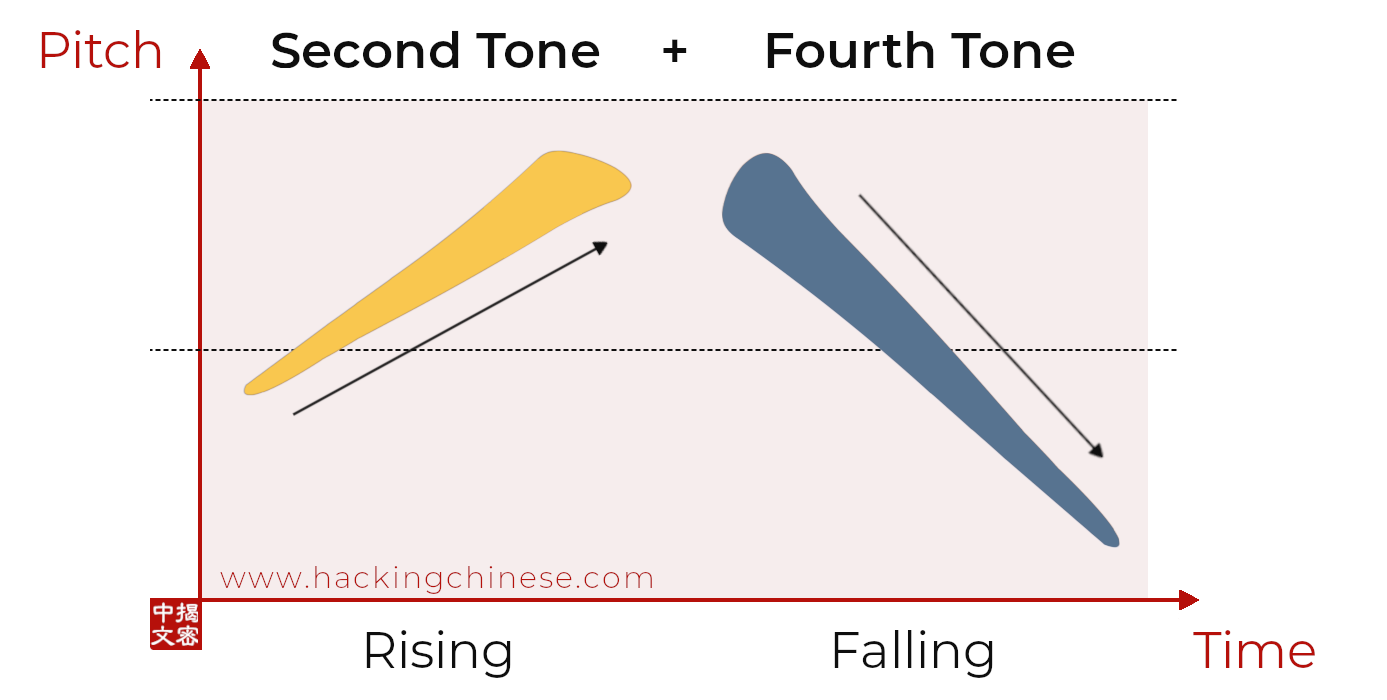 Second tone + Fourth tone
Second tone + Fourth tone
| HSK | Word | Pinyin |
| 1 | 前面 | qiánmiàn |
| 1 | 学校 | xuéxiào |
| 2 | 颜色 | yánsè |
| 2 | 羊肉 | yángròu |
| 2 | 一下 | yíxià |
| 3 | 不但 | búdàn |
| 3 | 成绩 | chéngjì |
| 3 | 城市 | chéngshì |
| 3 | 迟到 | chídào |
| 3 | 环境 | huánjìng |
| 3 | 节目 | jiémù |
| 3 | 结束 | jiéshù |
| 3 | 节日 | jiérì |
| 3 | 决定 | juédìng |
| 3 | 难过 | nánguò |
| 3 | 奇怪 | qíguài |
| 3 | 然后 | ránhòu |
| 3 | 容易 | róngyì |
| 3 | 同事 | tóngshì |
| 3 | 同意 | tóngyì |
| 3 | 文化 | wénhuà |
| 3 | 习惯 | xíguàn |
| 3 | 一定 | yídìng |
| 3 | 一共 | yígòng |
| 3 | 一会儿 | yíhuìr |
| 3 | 一样 | yíyàng |
| 3 | 游戏 | yóuxì |
| 4 | 博士 | bóshì |
| 4 | 不过 | búguò |
| 4 | 材料 | cáiliào |
| 4 | 乘坐 | chéngzuò |
| 4 | 答案 | dá’àn |
| 4 | 得意 | déyì |
| 4 | 国际 | guójì |
| 4 | 寒假 | hánjià |
| 4 | 合适 | héshì |
| 4 | 回忆 | huíyì |
| 4 | 活动 | huódòng |
| 4 | 来自 | láizì |
| 4 | 联系 | liánxì |
| 4 | 流利 | liúlì |
| 4 | 迷路 | mílù |
| 4 | 难道 | nándào |
| 4 | 难受 | nánshòu |
| 4 | 能力 | nénglì |
| 4 | 排队 | pái duì |
| 4 | 排列 | páiliè |
| 4 | 其次 | qícì |
| 4 | 情况 | qíngkuàng |
| 4 | 全部 | quánbù |
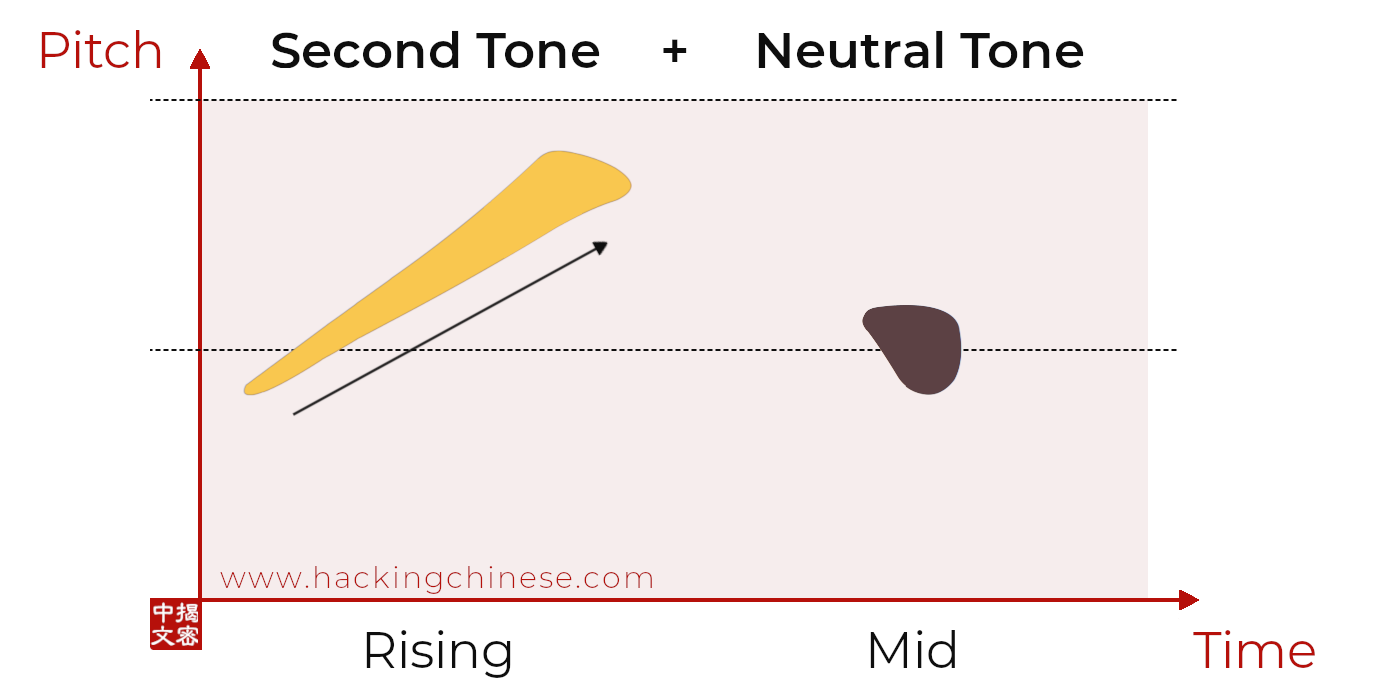 Second tone + Neutral tone
Second tone + Neutral tone
| HSK | Word | Pinyin |
| 1 | 儿子 | érzi |
| 1 | 名字 | míngzi |
| 1 | 朋友 | péngyou |
| 1 | 什么 | shénme |
| 1 | 时候 | shíhou |
| 1 | 学生 | xuésheng |
| 2 | 孩子 | háizi |
| 2 | 觉得 | juéde |
| 2 | 便宜 | piányi |
| 3 | 鼻子 | bízi |
| 3 | 别人 | biéren |
| 3 | 除了 | chúle |
| 3 | 还是 | háishi |
| 3 | 明白 | míngbai |
| 3 | 盘子 | pánzi |
| 3 | 瓶子 | píngzi |
| 3 | 裙子 | qúnzi |
| 3 | 头发 | tóufa |
| 3 | 爷爷 | yéye |
| 4 | 盒子 | hézi |
| 4 | 活泼 | huópo |
| 4 | 咳嗽 | késou |
| 4 | 凉快 | liángkuai |
| 4 | 麻烦 | máfan |
| 4 | 脾气 | píqi |
| 4 | 葡萄 | pútao |
| 4 | 勺子 | sháozi |
| 4 | 随着 | suízhe |
| 4 | 咱们 | zánmen |
| 4 | 值得 | zhíde |
| 5 | 脖子 | bózi |
| 5 | 合同 | hétong |
| 5 | 猴子 | hóuzi |
| 5 | 糊涂 | hútu |
| 5 | 桔子 | júzi |
| 5 | 粮食 | liángshi |
| 5 | 逻辑 | luóji |
| 5 | 馒头 | mántou |
| 5 | 眉毛 | méimao |
| 5 | 苗条 | miáotiao |
| 5 | 模糊 | móhu |
| 5 | 绳子 | shéngzi |
| 5 | 石头 | shítou |
| 5 | 学问 | xuéwen |
| 5 | 竹子 | zhúzi |
| 6 | 裁缝 | cáifeng |
| 6 | 残疾 | cánji |
| 6 | 含糊 | hánhu |
| 6 | 和气 | héqi |
| 6 | 唠叨 | láodao |
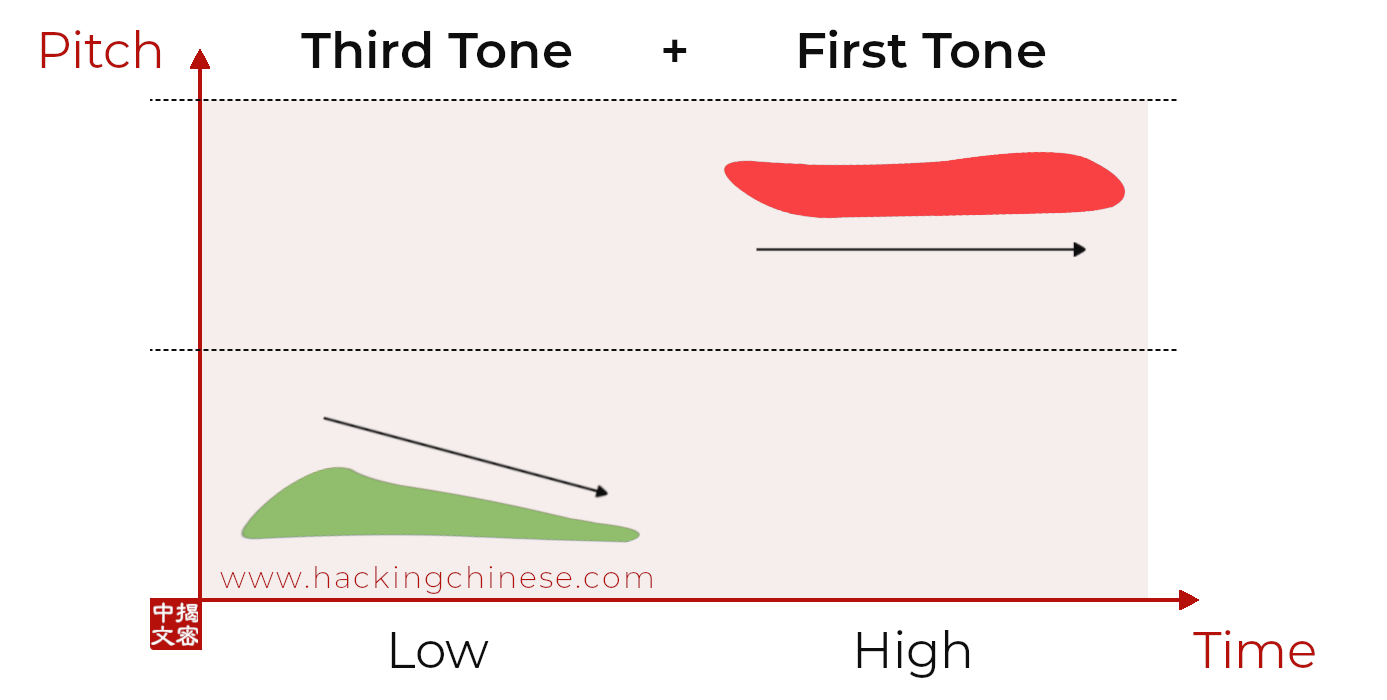 Third tone + First tone
Third tone + First tone
| HSK | Word | Pinyin |
| 1 | 北京 | běijīng |
| 1 | 老师 | lǎoshī |
| 2 | 好吃 | hǎochī |
| 2 | 手机 | shǒujī |
| 3 | 北方 | běifāng |
| 3 | 简单 | jiǎndān |
| 3 | 起飞 | qǐfēi |
| 3 | 小心 | xiǎoxīn |
| 4 | 饼干 | bǐnggān |
| 4 | 打针 | dǎzhēn |
| 4 | 堵车 | dǔchē |
| 4 | 广播 | guǎngbō |
| 4 | 果汁 | guǒzhī |
| 4 | 奖金 | jiǎngjīn |
| 4 | 紧张 | jǐnzhāng |
| 4 | 烤鸭 | kǎoyā |
| 4 | 可惜 | kěxī |
| 4 | 首都 | shǒudū |
| 4 | 首先 | shǒuxiān |
| 4 | 小吃 | xiǎochī |
| 4 | 小说 | xiǎoshuō |
| 4 | 许多 | xǔduō |
| 4 | 演出 | yǎnchū |
| 5 | 本科 | běnkē |
| 5 | 补充 | bǔchōng |
| 5 | 产生 | chǎnshēng |
| 5 | 打工 | dǎgōng |
| 5 | 感激 | gǎnjī |
| 5 | 拐弯 | guǎi wān |
| 5 | 海关 | hǎiguān |
| 5 | 海鲜 | hǎixiān |
| 5 | 假装 | jiǎzhuāng |
| 5 | 剪刀 | jiǎndāo |
| 5 | 酒吧 | jiǔbā |
| 5 | 卡车 | kǎchē |
| 5 | 启发 | qǐfā |
| 5 | 取消 | qǔxiāo |
| 5 | 始终 | shǐzhōng |
| 5 | 手工 | shǒugōng |
| 5 | 鼠标 | shǔ biāo |
| 5 | 损失 | sǔnshī |
| 5 | 体贴 | tǐtiē |
| 5 | 统一 | tǒngyī |
| 5 | 展开 | zhǎn kāi |
| 5 | 指挥 | zhǐhuī |
| 5 | 主观 | zhǔguān |
| 5 | 主张 | zhǔzhāng |
| 5 | 总之 | zǒngzhī |
| 5 | 组织 | zǔzhī |
| 6 | 把关 | bǎ guān |
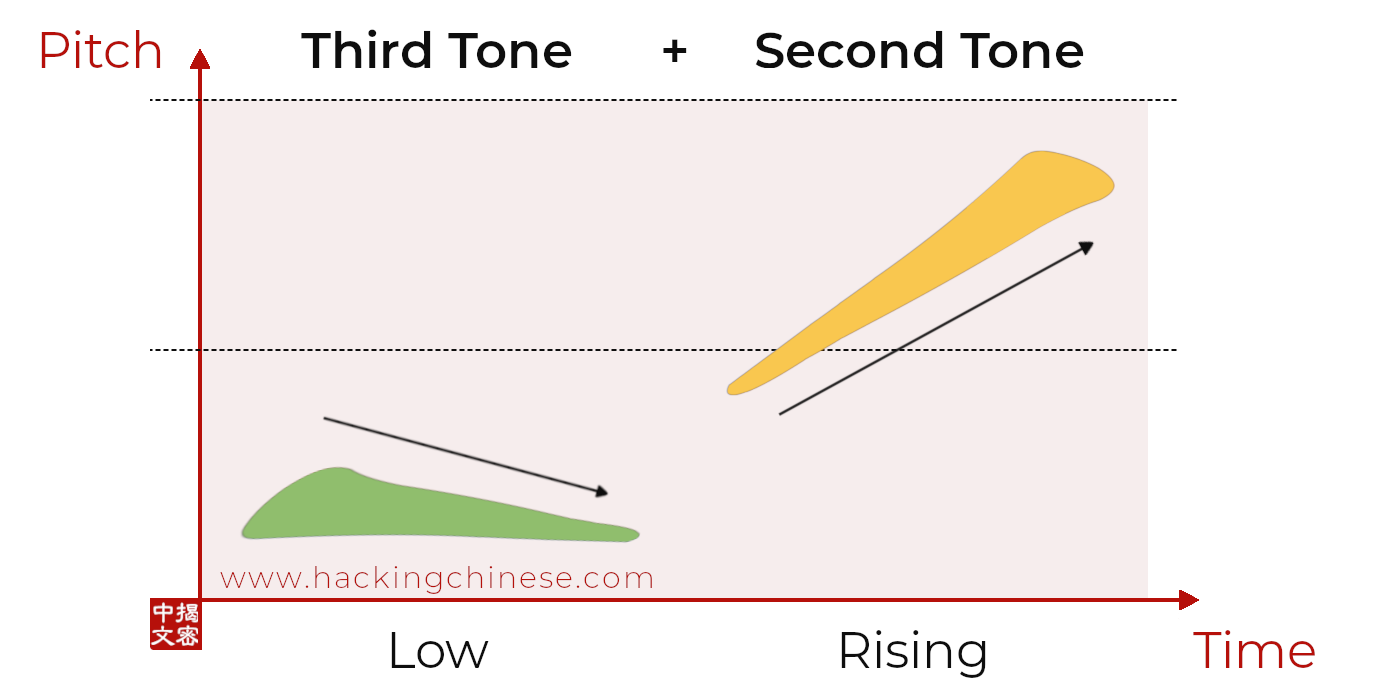 Third tone + Second tone
Third tone + Second tone
| HSK | Word | Pinyin |
| 1 | 女儿 | nǚ’ér |
| 2 | 可能 | kěnéng |
| 2 | 旅游 | lǚyóu |
| 2 | 起床 | qǐ chuáng |
| 2 | 小时 | xiǎoshí |
| 3 | 检查 | jiǎnchá |
| 3 | 解决 | jiějué |
| 3 | 水平 | shuǐpíng |
| 3 | 选择 | xuǎnzé |
| 3 | 以前 | yǐqián |
| 3 | 有名 | yǒumíng |
| 4 | 本来 | běnlái |
| 4 | 比如 | bǐrú |
| 4 | 表格 | biǎogé |
| 4 | 表扬 | biǎoyáng |
| 4 | 打折 | dǎzhé |
| 4 | 导游 | dǎoyóu |
| 4 | 否则 | fǒuzé |
| 4 | 感觉 | gǎnjué |
| 4 | 感情 | gǎnqíng |
| 4 | 海洋 | hǎiyáng |
| 4 | 减肥 | jiǎnféi |
| 4 | 警察 | jǐngchá |
| 4 | 举行 | jǔxíng |
| 4 | 可怜 | kělián |
| 4 | 旅行 | lǚxíng |
| 4 | 网球 | wǎngqiú |
| 4 | 演员 | yǎnyuán |
| 4 | 养成 | yǎngchéng |
| 4 | 以为 | yǐwéi |
| 4 | 语言 | yǔyán |
| 4 | 准时 | zhǔnshí |
| 4 | 总结 | zǒngjié |
| 5 | 保持 | bǎochí |
| 5 | 保存 | bǎocún |
| 5 | 保留 | bǎoliú |
| 5 | 表达 | biǎodá |
| 5 | 表明 | biǎomíng |
| 5 | 表情 | biǎoqíng |
| 5 | 彩虹 | cǎihóng |
| 5 | 倒霉 | dǎoméi |
| 5 | 等于 | děngyú |
| 5 | 躲藏 | duǒcáng |
| 5 | 耳环 | ěrhuán |
| 5 | 反而 | fǎn’ér |
| 5 | 仿佛 | fǎngfú |
| 5 | 改革 | gǎigé |
| 5 | 果然 | guǒrán |
| 5 | 果实 | guǒshí |
| 5 | 火柴 | huǒchái |
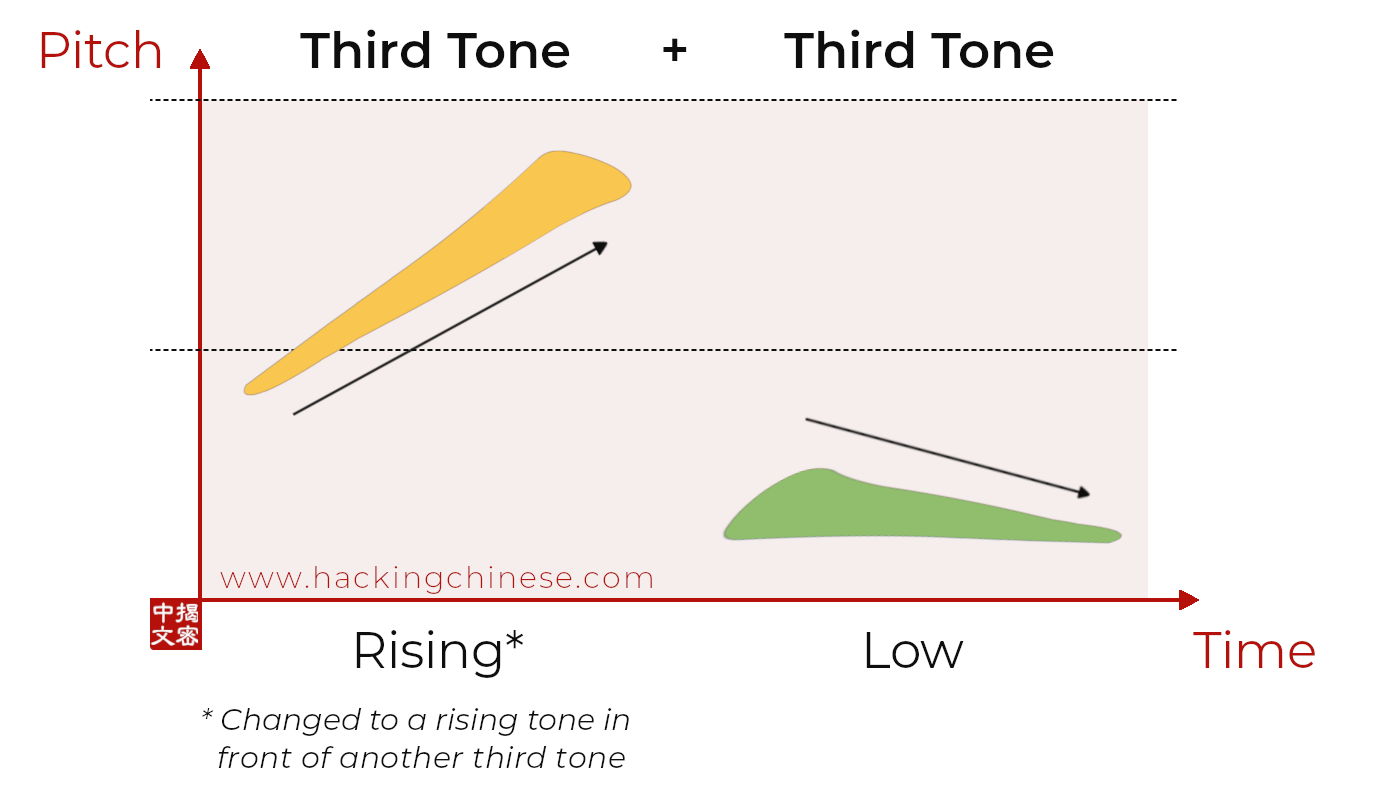 Third tone + Third tone
Third tone + Third tone
| HSK | Word | Pinyin |
| 1 | 水果 | shuǐguǒ |
| 2 | 可以 | kěyǐ |
| 2 | 手表 | shǒubiǎo |
| 2 | 所以 | suǒyǐ |
| 3 | 打扫 | dǎsǎo |
| 3 | 了解 | liǎojiě |
| 3 | 洗澡 | xǐzǎo |
| 3 | 影响 | yǐngxiǎng |
| 3 | 只有 | zhǐyǒu |
| 4 | 表演 | biǎoyǎn |
| 4 | 打扰 | dǎrǎo |
| 4 | 管理 | guǎnlǐ |
| 4 | 减少 | jiǎnshǎo |
| 4 | 尽管 | jǐnguǎn |
| 4 | 老虎 | lǎohǔ |
| 4 | 理解 | lǐjiě |
| 4 | 理想 | lǐxiǎng |
| 4 | 偶尔 | ǒu’ěr |
| 4 | 所有 | suǒyǒu |
| 4 | 往往 | wǎngwǎng |
| 4 | 也许 | yěxǔ |
| 4 | 引起 | yǐnqǐ |
| 4 | 永远 | yǒngyuǎn |
| 4 | 勇敢 | yǒnggǎn |
| 4 | 友好 | yǒuhǎo |
| 4 | 语法 | yǔfǎ |
| 4 | 允许 | yǔnxǔ |
| 4 | 整理 | zhěnglǐ |
| 4 | 只好 | zhǐhǎo |
| 5 | 保险 | bǎoxiǎn |
| 5 | 本领 | běnlǐng |
| 5 | 彼此 | bǐcǐ |
| 5 | 采访 | cǎifǎng |
| 5 | 采取 | cǎiqǔ |
| 5 | 产品 | chǎnpǐn |
| 5 | 处理 | chǔlǐ |
| 5 | 导演 | dǎoyǎn |
| 5 | 岛屿 | dǎoyǔ |
| 5 | 辅导 | fǔdǎo |
| 5 | 赶紧 | gǎnjǐn |
| 5 | 感想 | gǎnxiǎng |
| 5 | 古典 | gǔdiǎn |
| 5 | 鼓舞 | gǔwǔ |
| 5 | 鼓掌 | gǔ zhǎng |
| 5 | 广场 | guǎngchǎng |
| 5 | 缓解 | huǎnjiě |
| 5 | 老板 | lǎobǎn |
| 5 | 老鼠 | lǎoshǔ |
| 5 | 了不起 | liǎobuqǐ |
| 5 | 领导 | lǐngdǎo |
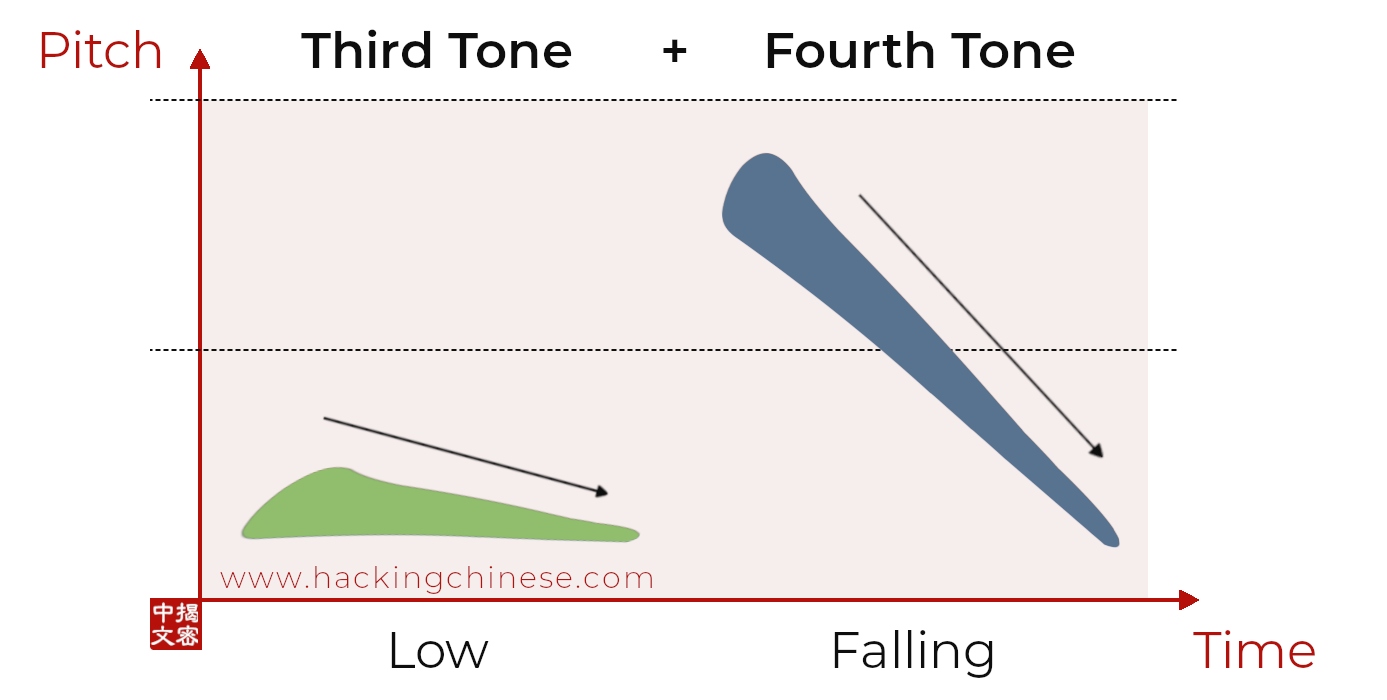 Third tone + Fourth tone
Third tone + Fourth tone
| HSK | Word | Pinyin |
| 1 | 米饭 | mǐfàn |
| 1 | 怎么样 | zěnmeyàng |
| 2 | 考试 | kǎoshì |
| 2 | 跑步 | pǎobù |
| 2 | 准备 | zhǔnbèi |
| 3 | 比较 | bǐjiào |
| 3 | 比赛 | bǐsài |
| 3 | 打算 | dǎsuàn |
| 3 | 感冒 | gǎnmào |
| 3 | 可爱 | kě’ài |
| 3 | 礼物 | lǐwù |
| 3 | 马上 | mǎshàng |
| 3 | 满意 | mǎnyì |
| 3 | 努力 | nǔlì |
| 3 | 请假 | qǐngjià |
| 3 | 体育 | tǐyù |
| 3 | 饮料 | yǐnliào |
| 3 | 主要 | zhǔyào |
| 3 | 总是 | zǒngshì |
| 4 | 保护 | bǎohù |
| 4 | 保证 | bǎozhèng |
| 4 | 表示 | biǎoshì |
| 4 | 打印 | dǎyìn |
| 4 | 短信 | duǎnxìn |
| 4 | 法律 | fǎlǜ |
| 4 | 反对 | fǎnduì |
| 4 | 改变 | gǎibiàn |
| 4 | 感动 | gǎndòng |
| 4 | 感谢 | gǎnxiè |
| 4 | 鼓励 | gǔlì |
| 4 | 广告 | guǎnggào |
| 4 | 好像 | hǎoxiàng |
| 4 | 解释 | jiěshì |
| 4 | 景色 | jǐngsè |
| 4 | 举办 | jǔbàn |
| 4 | 考虑 | kǎolǜ |
| 4 | 可是 | kěshì |
| 4 | 肯定 | kěndìng |
| 4 | 恐怕 | kǒngpà |
| 4 | 冷静 | lěngjìng |
| 4 | 礼貌 | lǐmào |
| 4 | 理发 | lǐfà |
| 4 | 美丽 | měilì |
| 4 | 免费 | miǎn fèi |
| 4 | 普遍 | pǔbiàn |
| 4 | 使用 | shǐyòng |
| 4 | 讨论 | tǎolùn |
| 4 | 讨厌 | tǎoyàn |
| 4 | 网站 | wǎngzhàn |
| 4 | 眼镜 | yǎnjìng |
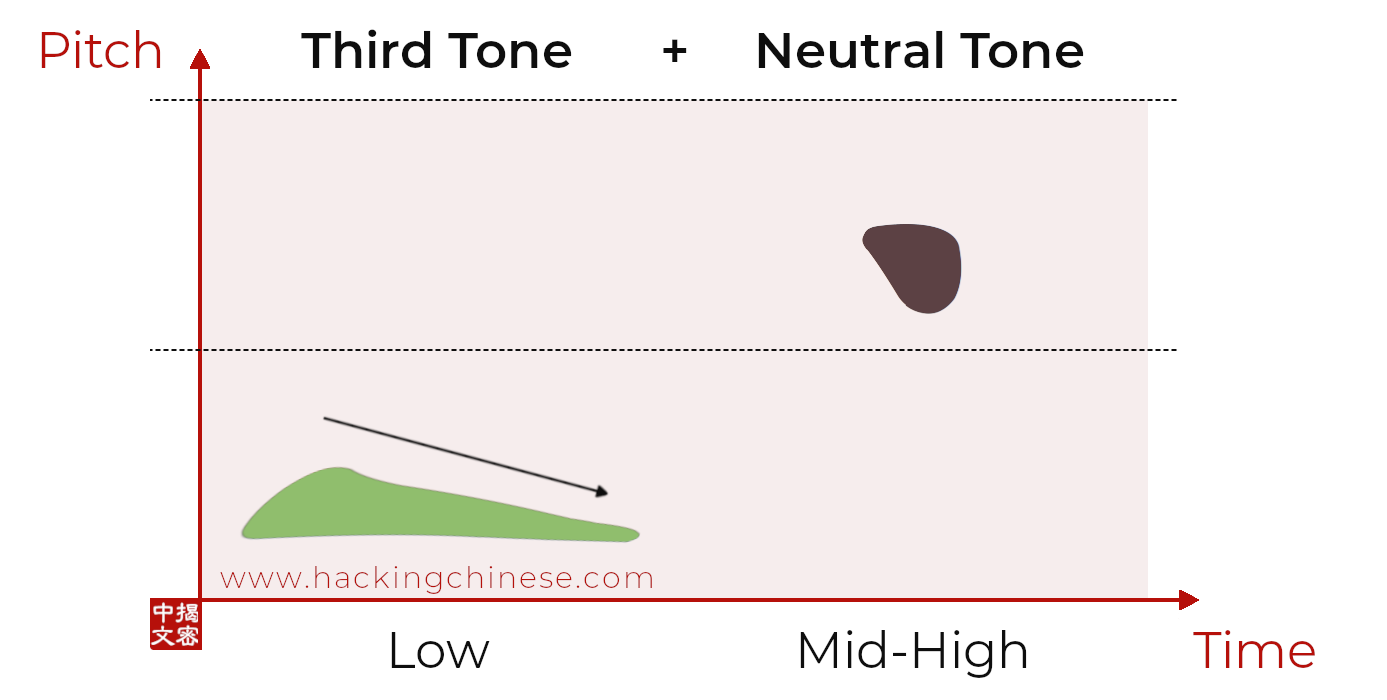 Third tone + Neutral tone
Third tone + Neutral tone
| HSK | Word | Pinyin |
| 1 | 我们 | wǒmen |
| 1 | 喜欢 | xǐhuan |
| 1 | 小姐 | xiǎojie |
| 1 | 椅子 | yǐzi |
| 1 | 怎么 | zěnme |
| 2 | 姐姐 | jiějie |
| 2 | 晚上 | wǎnshang |
| 2 | 眼睛 | yǎnjing |
| 2 | 已经 | yǐjing |
| 2 | 早上 | zǎoshang |
| 2 | 左边 | zuǒbian |
| 3 | 耳朵 | ěrduo |
| 3 | 奶奶 | nǎinai |
| 3 | 起来 | qǐlai |
| 4 | 打扮 | dǎban |
| 4 | 好处 | hǎochu |
| 4 | 饺子 | jiǎozi |
| 4 | 马虎 | mǎhu |
| 4 | 母亲 | mǔqin |
| 4 | 暖和 | nuǎnhuo |
| 4 | 主意 | zhǔyi |
| 5 | 尺子 | chǐzi |
| 5 | 打听 | dǎting |
| 5 | 点心 | diǎnxin |
| 5 | 骨头 | gǔtou |
| 5 | 管子 | guǎnzi |
| 5 | 讲究 | jiǎngjiu |
| 5 | 老实 | lǎoshi |
| 5 | 姥姥 | lǎolao |
| 5 | 脑袋 | nǎodai |
| 5 | 嗓子 | sǎngzi |
| 5 | 舍不得 | shěbude |
| 5 | 尾巴 | wěiba |
| 5 | 委屈 | wěiqu |
| 5 | 显得 | xiǎnde |
| 5 | 影子 | yǐngzi |
| 6 | 把手 | ba3shou |
| 6 | 本事 | ben3shi |
| 6 | 比方 | bi3fang |
| 6 | 打量 | da3liang |
| 6 | 恶心 | e3xin |
| 6 | 喇叭 | la3ba |
| 6 | 码头 | ma3tou |
| 6 | 免得 | mian3de |
| 6 | 曲子 | qu3zi |
| 6 | 嫂子 | sao3zi |
| 6 | 妥当 | tuo3dang |
| 6 | 枕头 | zhen3tou |
| 6 | 指甲 | zhi3jia |
| 6 | 种子 | zhong3zi |
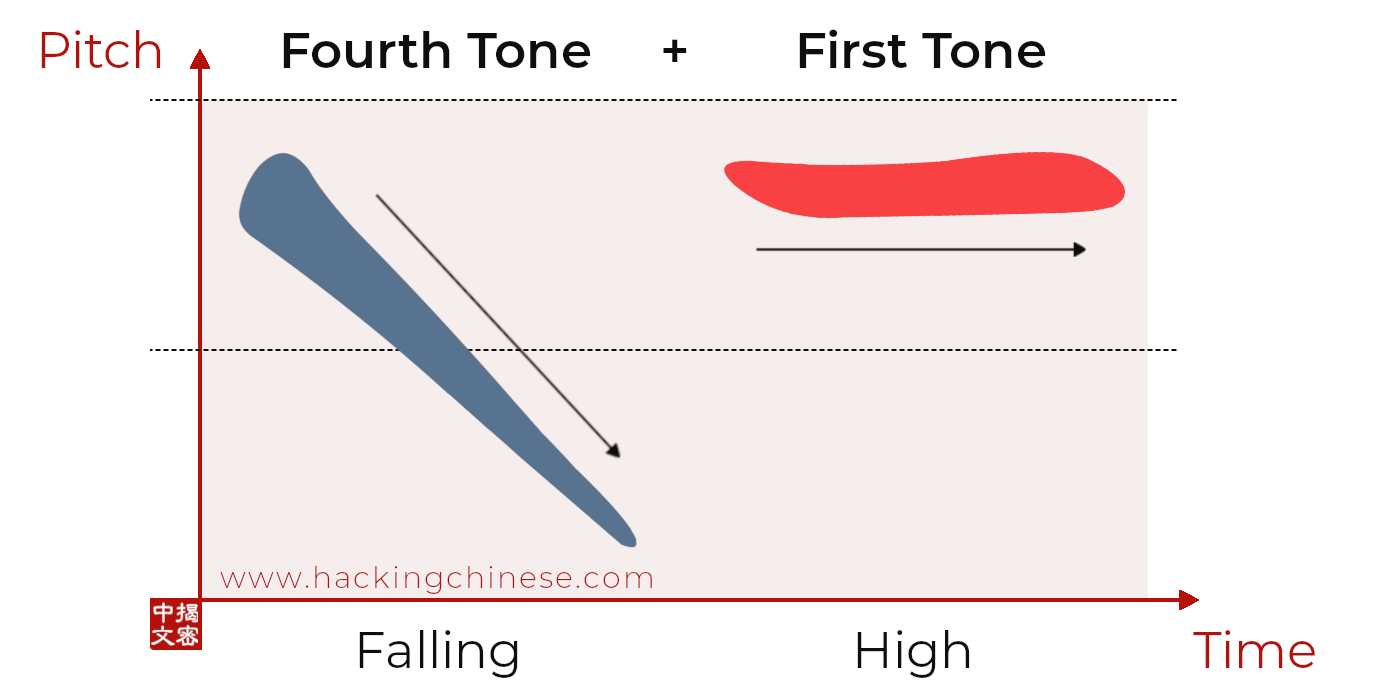 Fourth tone + First tone
Fourth tone + First tone
| HSK | Word | Pinyin |
| 2 | 唱歌 | chànggē |
| 2 | 大家 | dàjiā |
| 2 | 第一 | dìyī |
| 2 | 上班 | shàngbān |
| 3 | 必须 | bìxū |
| 3 | 菜单 | càidān |
| 3 | 衬衫 | chènshān |
| 3 | 蛋糕 | dàngāo |
| 3 | 电梯 | diàntī |
| 3 | 放心 | fàngxīn |
| 3 | 健康 | jiànkāng |
| 3 | 面包 | miànbāo |
| 3 | 认真 | rènzhēn |
| 3 | 一般 | yìbān |
| 3 | 一边 | yìbiān |
| 4 | 差不多 | chàbuduō |
| 4 | 大约 | dàyuē |
| 4 | 放松 | fàngsōng |
| 4 | 害羞 | hài xiū |
| 4 | 互相 | hùxiāng |
| 4 | 降低 | jiàngdī |
| 4 | 竞争 | jìngzhēng |
| 4 | 客厅 | kètīng |
| 4 | 律师 | lǜshī |
| 4 | 耐心 | nàixīn |
| 4 | 现金 | xiànjīn |
| 4 | 信封 | xìnfēng |
| 4 | 信息 | xìnxī |
| 4 | 信心 | xìnxīn |
| 4 | 亚洲 | yàzhōu |
| 4 | 作家 | zuòjiā |
| 5 | 爱惜 | àixī |
| 5 | 爱心 | àixīn |
| 5 | 不安 | bù’ān |
| 5 | 刺激 | cìjī |
| 5 | 措施 | cuòshī |
| 5 | 地区 | dìqū |
| 5 | 对方 | duìfāng |
| 5 | 冠军 | guànjūn |
| 5 | 过期 | guòqī |
| 5 | 健身 | jiànshēn |
| 5 | 据说 | jùshuō |
| 5 | 客观 | kèguān |
| 5 | 辣椒 | làjiāo |
| 5 | 乐观 | lèguān |
| 5 | 利息 | lìxī |
| 5 | 列车 | lièchē |
| 5 | 录音 | lùyīn |
| 5 | 蜜蜂 | mìfēng |
| 5 | 面积 | miànjī |
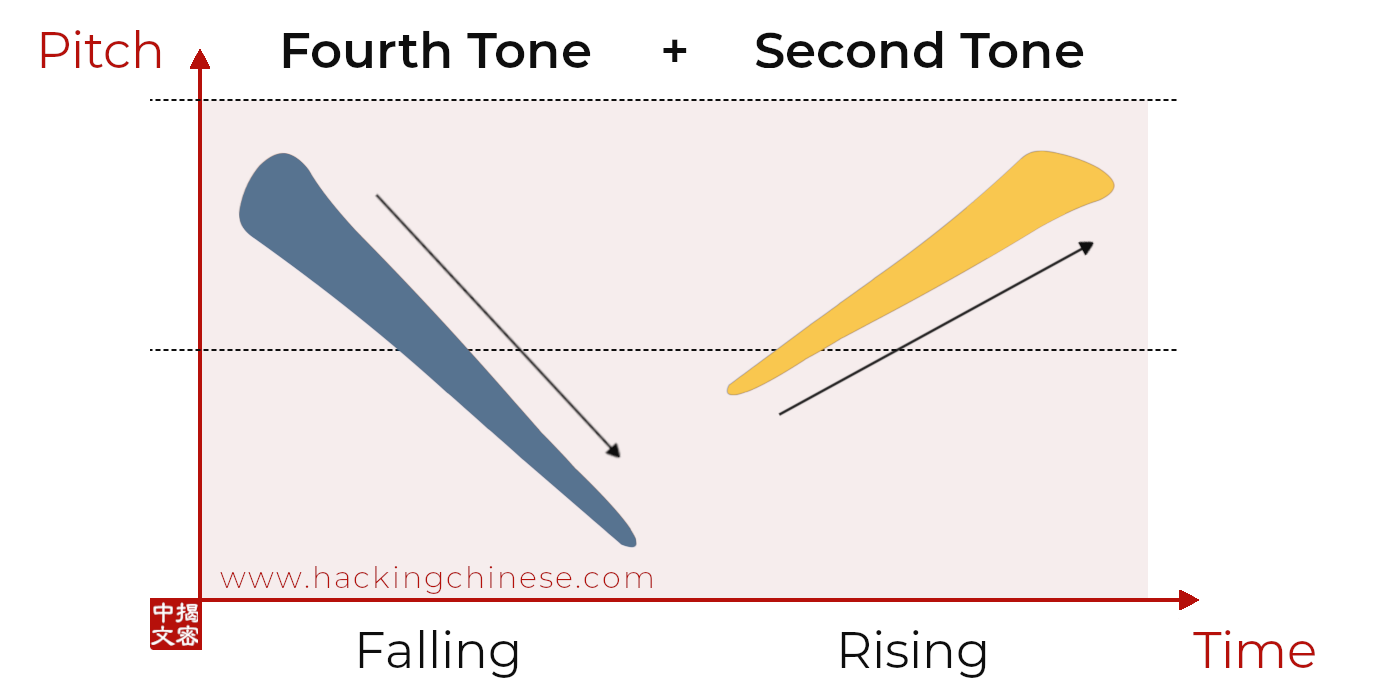 Fourth tone + Second tone
Fourth tone + Second tone
| HSK | Word | Pinyin |
| 2 | 面条 | miàntiáo |
| 2 | 去年 | qùnián |
| 2 | 问题 | wèntí |
| 3 | 地图 | dìtú |
| 3 | 复习 | fùxí |
| 3 | 后来 | hòulái |
| 3 | 季节 | jìjié |
| 3 | 客人 | kèrén |
| 3 | 练习 | liànxí |
| 3 | 热情 | rèqíng |
| 3 | 认为 | rènwéi |
| 3 | 数学 | shùxué |
| 3 | 太阳 | tàiyáng |
| 3 | 特别 | tèbié |
| 3 | 一直 | yìzhí |
| 4 | 爱情 | àiqíng |
| 4 | 按时 | ànshí |
| 4 | 报名 | bào míng |
| 4 | 地球 | dìqiú |
| 4 | 调查 | diàochá |
| 4 | 对于 | duìyú |
| 4 | 负责 | fùzé |
| 4 | 复杂 | fùzá |
| 4 | 共同 | gòngtóng |
| 4 | 过程 | guòchéng |
| 4 | 获得 | huòdé |
| 4 | 既然 | jìrán |
| 4 | 价格 | jiàgé |
| 4 | 进行 | jìnxíng |
| 4 | 竟然 | jìngrán |
| 4 | 拒绝 | jùjué |
| 4 | 距离 | jùlí |
| 4 | 例如 | lìrú |
| 4 | 内容 | nèiróng |
| 4 | 确实 | quèshí |
| 4 | 任何 | rènhé |
| 4 | 适合 | shìhé |
| 4 | 橡皮 | xiàngpí |
| 4 | 幸福 | xìngfú |
| 4 | 性别 | xìngbié |
| 4 | 性格 | xìnggé |
| 4 | 预习 | yùxí |
| 4 | 阅读 | yuèdú |
| 4 | 暂时 | zànshí |
| 4 | 正常 | zhèngcháng |
| 4 | 证明 | zhèngmíng |
| 4 | 著名 | zhùmíng |
| 4 | 自然 | zìrán |
| 5 | 必然 | bìrán |
| 5 | 病毒 | bìngdú |
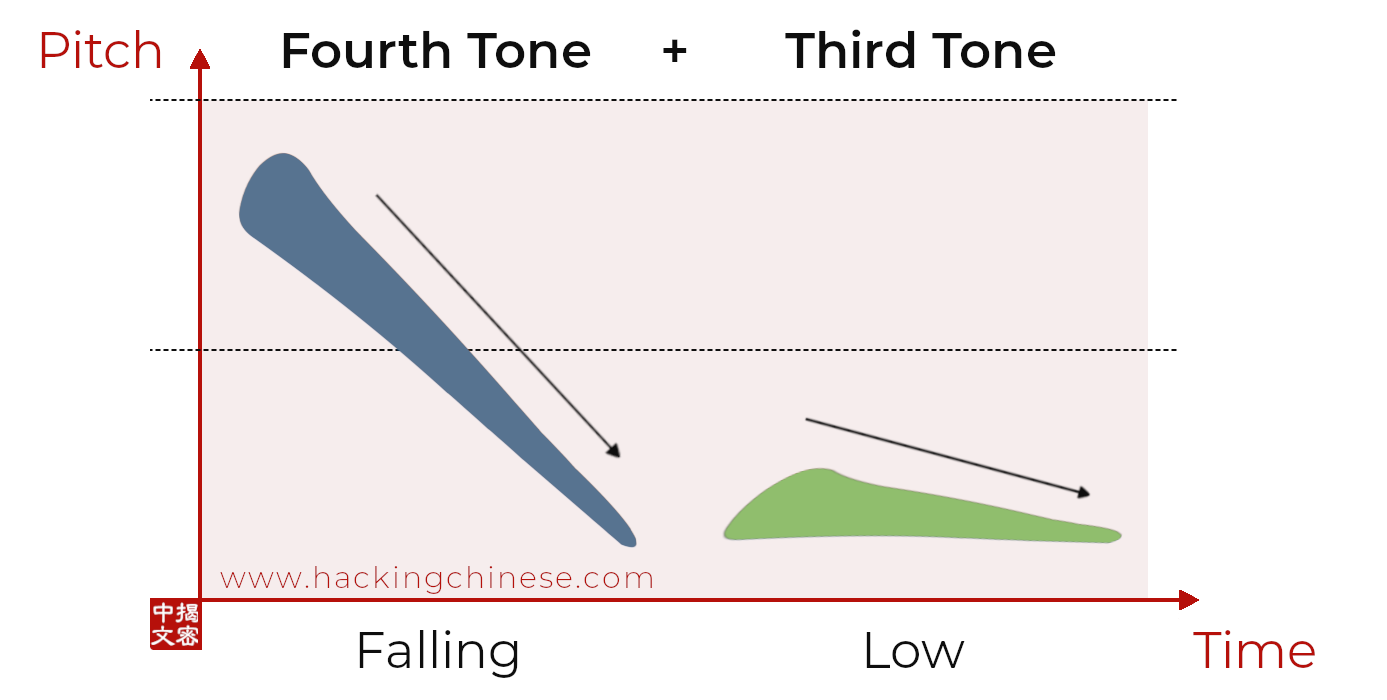 Fourth tone + Third tone
Fourth tone + Third tone
| HSK | Word | Pinyin |
| 1 | 电脑 | diànnǎo |
| 1 | 电影 | diànyǐng |
| 1 | 对不起 | duìbuqǐ |
| 1 | 汉语 | hànyǔ |
| 1 | 上午 | shàngwǔ |
| 1 | 下午 | xiàwǔ |
| 1 | 下雨 | xiàyǔ |
| 1 | 一点儿 | yìdiǎnr |
| 2 | 报纸 | bàozhǐ |
| 2 | 跳舞 | tiàowǔ |
| 2 | 一起 | yìqǐ |
| 3 | 办法 | bànfǎ |
| 3 | 地铁 | dìtiě |
| 3 | 或者 | huòzhě |
| 3 | 历史 | lìshǐ |
| 3 | 上网 | shàngwǎng |
| 3 | 校长 | xiàozhǎng |
| 3 | 自己 | zìjǐ |
| 4 | 并且 | bìngqiě |
| 4 | 不管 | bùguǎn |
| 4 | 不仅 | bùjǐn |
| 4 | 厕所 | cèsuǒ |
| 4 | 到底 | dào dǐ |
| 4 | 地点 | dìdiǎn |
| 4 | 地址 | dìzhǐ |
| 4 | 付款 | fù kuǎn |
| 4 | 号码 | hàomǎ |
| 4 | 后悔 | hòuhuǐ |
| 4 | 记者 | jìzhě |
| 4 | 禁止 | jìnzhǐ |
| 4 | 看法 | kànfǎ |
| 4 | 密码 | mìmǎ |
| 4 | 入口 | rùkǒu |
| 4 | 是否 | shìfǒu |
| 4 | 特点 | tèdiǎn |
| 4 | 效果 | xiàoguǒ |
| 4 | 正好 | zhènghǎo |
| 4 | 至少 | zhìshǎo |
| 4 | 重点 | zhòngdiǎn |
| 4 | 最好 | zuìhǎo |
| 4 | 作者 | zuòzhě |
| 5 | 办理 | bànlǐ |
| 5 | 傍晚 | bàngwǎn |
| 5 | 背景 | bèijǐng |
| 5 | 避免 | bìmiǎn |
| 5 | 彻底 | chèdǐ |
| 5 | 翅膀 | chìbǎng |
| 5 | 促使 | cùshǐ |
| 5 | 代表 | dàibiǎo |
| 5 | 贷款 | dài kuǎn |
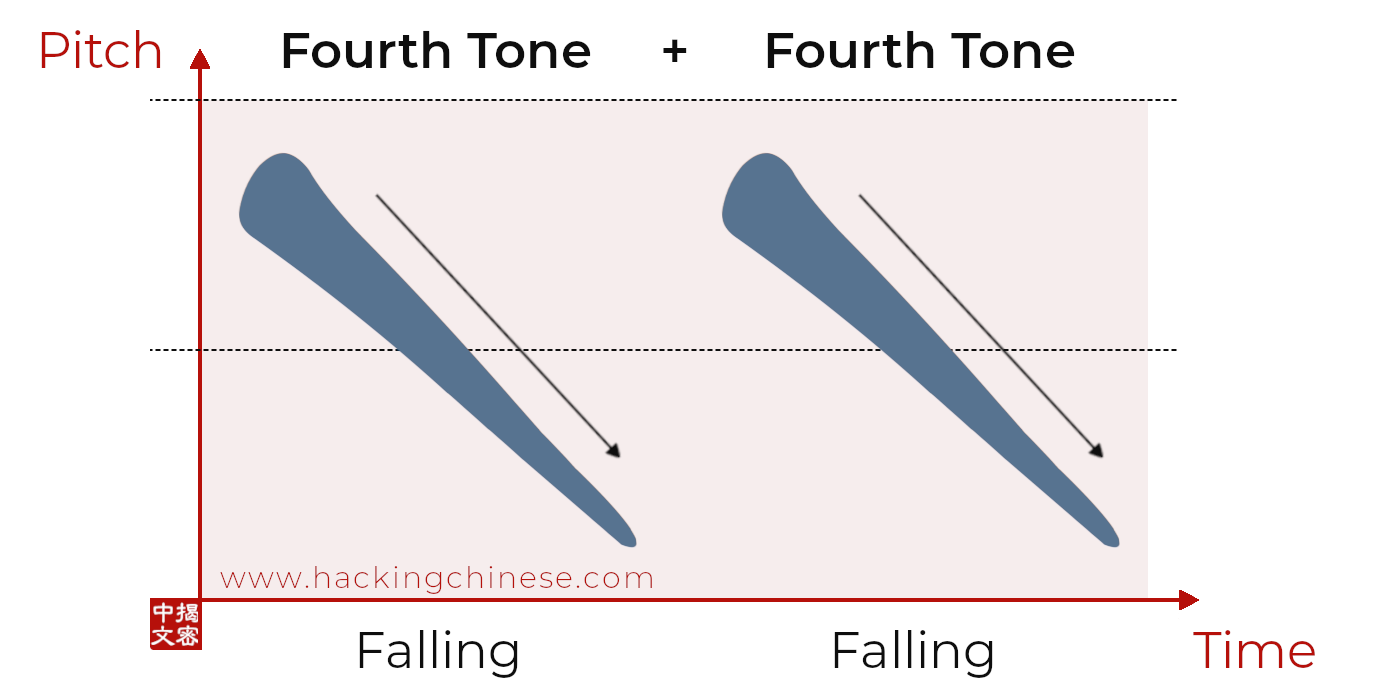 Fourth tone + Fourth tone
Fourth tone + Fourth tone
| HSK | Word | Pinyin |
| 1 | 电视 | diànshì |
| 1 | 饭店 | fàndiàn |
| 1 | 看见 | kànjiàn |
| 1 | 睡觉 | shuìjiào |
| 1 | 现在 | xiànzài |
| 1 | 再见 | zàijiàn |
| 2 | 但是 | dànshì |
| 2 | 教室 | jiàoshì |
| 2 | 介绍 | jièshào |
| 2 | 快乐 | kuàilè |
| 2 | 运动 | yùndòng |
| 2 | 正在 | zhèngzài |
| 3 | 爱好 | àihào |
| 3 | 变化 | biànhuà |
| 3 | 动物 | dòngwù |
| 3 | 锻炼 | duànliàn |
| 3 | 附近 | fùjìn |
| 3 | 过去 | guòqù |
| 3 | 害怕 | hàipà |
| 3 | 护照 | hùzhào |
| 3 | 会议 | huìyì |
| 3 | 见面 | jiànmiàn |
| 3 | 世界 | shìjiè |
| 3 | 忘记 | wàngjì |
| 3 | 遇到 | yùdào |
| 3 | 愿意 | yuànyì |
| 3 | 照片 | zhàopiàn |
| 3 | 重要 | zhòngyào |
| 3 | 注意 | zhùyì |
| 3 | 最后 | zuìhòu |
| 3 | 最近 | zuìjìn |
| 3 | 作业 | zuòyè |
| 4 | 按照 | ànzhào |
| 4 | 抱歉 | bàoqiàn |
| 4 | 毕业 | bì yè |
| 4 | 错误 | cuòwù |
| 4 | 大概 | dàgài |
| 4 | 到处 | dàochù |
| 4 | 道歉 | dàoqiàn |
| 4 | 动作 | dòngzuò |
| 4 | 对话 | duìhuà |
| 4 | 对面 | duìmiàn |
| 4 | 放弃 | fàngqì |
| 4 | 复印 | fùyìn |
| 4 | 购物 | gòuwù |
| 4 | 故意 | gùyì |
| 4 | 顾客 | gùkè |
| 4 | 计划 | jìhuà |
| 4 | 技术 | jìshù |
| 4 | 继续 | jìxù |
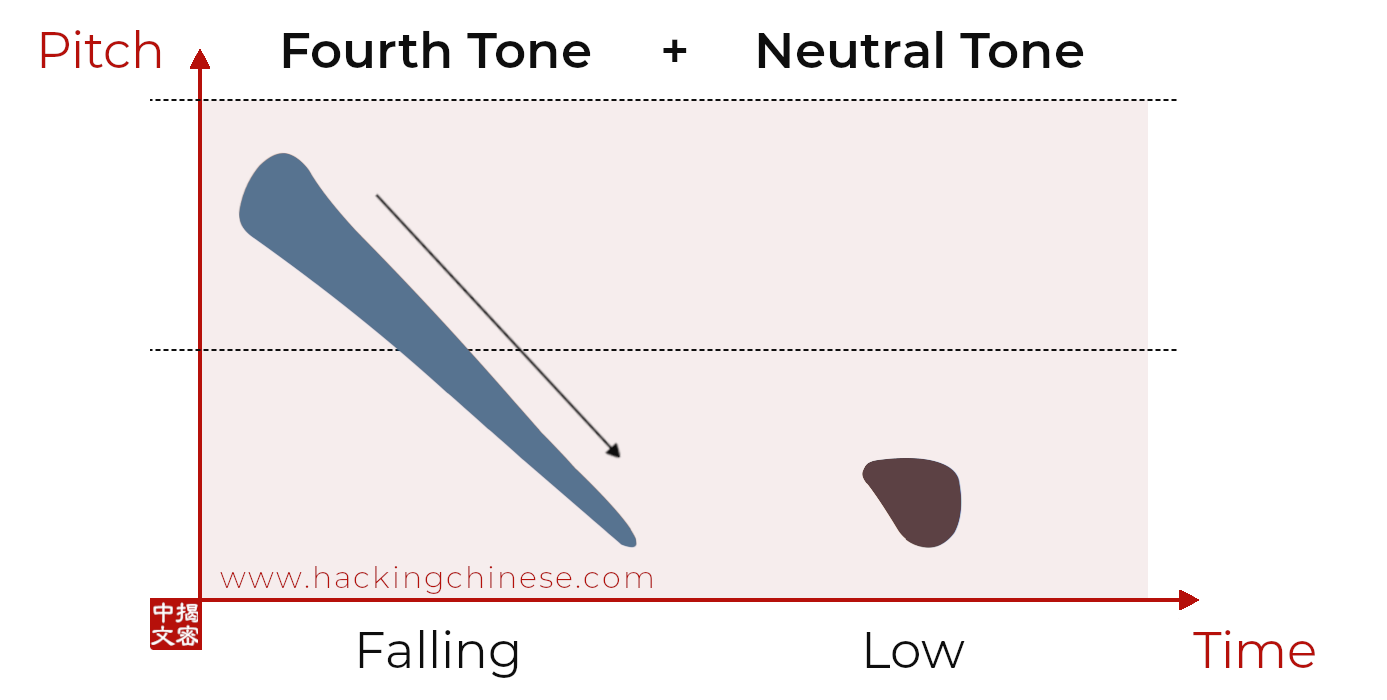 Fourth tone + Neutral tone
Fourth tone + Neutral tone
| HSK | Word | Pinyin |
| 1 | 爸爸 | bàba |
| 1 | 后面 | hòumian |
| 1 | 漂亮 | piàoliang |
| 1 | 认识 | rènshi |
| 1 | 谢谢 | xièxie |
| 2 | 弟弟 | dìdi |
| 2 | 告诉 | gàosu |
| 2 | 妹妹 | mèimei |
| 2 | 事情 | shìqing |
| 2 | 意思 | yìsi |
| 2 | 右边 | yòubian |
| 2 | 丈夫 | zhàngfu |
| 3 | 地方 | dìfang |
| 3 | 个子 | gèzi |
| 3 | 故事 | gùshi |
| 3 | 记得 | jìde |
| 3 | 句子 | jùzi |
| 3 | 裤子 | kùzi |
| 3 | 筷子 | kuàizi |
| 3 | 帽子 | màozi |
| 3 | 为了 | wèile |
| 3 | 月亮 | yuèliang |
| 3 | 照顾 | zhàogu |
| 4 | 部分 | bùfen |
| 4 | 大夫 | dàifu |
| 4 | 肚子 | dùzi |
| 4 | 父亲 | fùqin |
| 4 | 护士 | hùshi |
| 4 | 镜子 | jìngzi |
| 4 | 困难 | kùnnan |
| 4 | 力气 | lìqi |
| 4 | 厉害 | lìhai |
| 4 | 热闹 | rènao |
| 4 | 任务 | rènwu |
| 4 | 态度 | tàidu |
| 4 | 袜子 | wàzi |
| 4 | 味道 | wèidao |
| 4 | 笑话 | xiàohua |
| 4 | 样子 | yàngzi |
| 4 | 要是 | yàoshi |
| 4 | 钥匙 | yàoshi |
| 4 | 叶子 | yèzi |
| 5 | 被子 | bèizi |
| 5 | 大方 | dàfang |
| 5 | 地道 | dìdao |
| 5 | 豆腐 | dòufu |
| 5 | 教训 | jiàoxun |
| 5 | 戒指 | jièzhi |
| 5 | 舅舅 | jiùjiu |
| 5 | 力量 | lìliang |

Tips and tricks for how to learn Chinese directly in your inbox
I've been learning and teaching Chinese for more than a decade. My goal is to help you find a way of learning that works for you. Sign up to my newsletter for a 7-day crash course in how to learn, as well as weekly ideas for how to improve your learning!
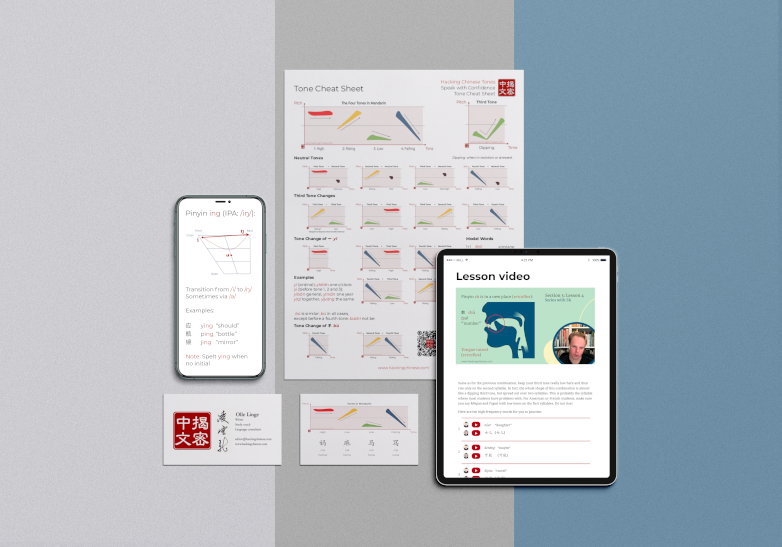
44 comments
Hi Olle,
My belief is that the more one isolates tones from everyday conversation, the less one is able to use proper tones in conversation. Even just reading conversational dui hua over and over with the accompanying recording is more beneficial than isolating words, in my opinion.
Interesting and useful lists. I am happy you posted the list in the article as the downloads seem not to work with Libre Office in Linux (maybe just Windows)
I can cut and paste to get around the problem.
Resolved the Linux/Libre Office issue… had to load fonts.
At 167 pages in PDF form, the list is exhaustive. I suspect that it needs to be broken down into something like 5 levels of frequency of use to really help learner.
The formats you provide allow someone to do exactly that. But one would have to find an exhaustive frequency of use reference to collate.
At the TOCFL site, located 8000 words broken out into 4 levels in PDF files… bot not sorted by pairs.
Very useful for some forms of review, and could be applied to the pair files in excel for more usefullness.
I’m not sure what you mean! The TOCFL lists seem to work properly here. They are already broken down into five levels of the test and they are sorted by tone combination. Can you please be more specific with what isn’t working or what needs to be done? It seems to look as designed here.
This is a nice article related to the topic of a book that I published last year. I think we think alike when it comes to helping others learn Chinese. In my book I list a large number of words in each 2-character tone combination (16) and each 3-character tone combinations (64) containing more than 3100 samples with recordings.
But one thing you’re missing in this analysis is the uneven distribution of tones from Ancient Chinese. In my book, for each sample I demonstrate the movement of the original tone (one of eight) into Modern Mandarin and also show the loss of -p -t -k -c endings wherever those characters show up. This is a helpful reference to anyone who wants to continue on to learn other Chinese languages like Southern Min that still retain these differences.
The book is mostly a tool for practicing pronunciation but I hope it also becomes a useful reference tool, and can still be found as a free download on my website.
-Mike Campbell
Please list your website so we can find your book. Thank you.
“but since most people probably don’t need that” Well, it’s exactly what I’ve been looking for for a long time. I’ve got a huge list of vocabulary on my computer, and I feel like sorting them by tone would be amazingly helpful. Is there anyway this could be made available, or maybe you know of a similar program that could pull this of?
Thanks in advance!
If you look in the paragraph above the one you cited, there is a link to the script on GitHub.
All right, after playing around a bit with the script, I think I’m not tech savvy enough to really get what I have to do… I don’t really know how to tell the script which file it needs sort into tones, and how to get a file which has the lay-out the script wants (two fields, annotated with pinyin etc.), I’ve just got a huge CSV file with words, but no pinyin. It would be awesome if I could make it work however.
I don’t know Python but this
“def main(argv):
(inputfile, outputfile) = parse_input(argv)”
seems to suggest that you have to put the directory to input and output files on the command line.
https://www.tutorialspoint.com/python/python_command_line_arguments.htm
Our Hanping Chinese Soundbox Android app allows you to practice tone pairs. For each tone pair, there are a few audio recordings included for free and an in-app purchase unlocks recordings for a further 4000 two-syllable words. Also includes sections for Tone Sandhi.
https://play.google.com/store/apps/details?id=com.embermitre.hanping.app.soundbox
This soundbox app is now rolled into our Hanping Chinese Dictionary Lite & Pro apps.
https://play.google.com/store/apps/dev?id=4845954736942800726
Hi Olle,
what an excellent article. I believe that you are right. Many textbooks really are not good enough to teach the proper pronunciation of the tones. I actually believe that they cant be tought from a book. As a Chinese Wing Tsun martial arts instructor I know for a fact that the tones and martial arts are both the same… you cant just open a book, read it and think you are good at it, you just need to practice and get feedback from an experienced person (a native Chinese speaker when we talk about Chinese…. or martial art master… when we talk about martial arts). Hope you will keep up the good work. I really do enjoy your site.
Brett
Hello. Very insightful article.
By any chance, do you have the audio files for all these cobinations? I’ve bought the app called Hanping SoundBox to practice the combinations i most have troubles regognising, but i want the audio files to create a kind of game.
Thank you very much!
Just a quick heads-up that Hanping Soundbox is now rolled into our dictionary apps: https://hanpingchinese.com/apps although the raw audio files are still not available!
Hi Olle,
Great stuff and good advice. Thank you. I’m somewhat new to your site but have noticed that a few of the resources you suggest, including one in this article, don’t seem to have working links to them anymore. I was wondering if you know of a way people could still access them. Currently, I have been unable to access anything at sinosplice, or specifically John’s Mandarin Chinese Tone Pair Drills:
http://www.sinosplice.com/learn-chinese/tone-pair-drills
and anything at Chinesepod, including their “extensive” library.
Do you know if these organization’s still exist? Perhaps they have moved their content to a different site?
Dear Ollie,
This article is very helpful to me a newbie who is learning Mandarin at home with no tutor. If I may recommend that you have an interactive version where persons can listen to tone pair pronounciation and record their pronounciation and can hear themselves and make corrections accordingly. There are several websites doing just that but they don’t have the list which you have used.
That would be awesome, but I don’t have the resources to record thousands of audio samples and present them online in a reasonable way!
Special thanks to HackingChinese.com for these word lists, they have proved invaluable to me. I created Videos, MP3s and PDFs based on them not only to help improve my pronunciation but, in the spirit of HackingChinese.com, to help others as well. I hired a native speaker to record the audio so it is first rate. All of my creations are available FREE (no sign up required) on my blog mandarinmania.com with credit given to HackingChinese.com for creating the lists. Thanks again HackingChinese.com!
Hi Olle,
Thanks for this article. For the HSK list that you provided in Excel, do you mind uploading another version where it ignores the HSK level so it’s a genuine sorted list of all the tone pairs? Thanks.
Hi Alan,
Fixed! I should really go through and rewrite/recreate this article, but in the meantime, I have updated the Excel file. It does not ignore HSK level completely, so it still sorts on HSK level, but now only within each tone combination (same as the list shown at the end of the article).
Hello brother Olle ,
first , a big and huge thanks to you , this blog is a gold mine when it comes to learning Chinese i really appreciate your hard work and everything you provide for the hacking Chinese community ,
brother Olle i searched all the net for a tool or something to sort Chinese characters and words based on the pinyin TONES , but i did only find your script which eventually i don’t how to execute …
i want to ask you kindly to make for us a blog post or a Youtube video explaining how to sort Chinese words or characters based on their tones with the script your friend has made for you , you had given the link to the script on github in your blog post :
https://www.hackingchinese.com/focusing-on-tone-pairs-to-improve-your-mandarin-pronunciation/?replytocom=60294#respond
i really need you to do a quick tutorial on how you sorted the HSK words lists based on TONE pairs (starting with single syllables tones 1,2,3,4,5
and then sorting words based on the famous TONE pairs (1,1 …1,5 …. then 4,1 …4,5 and so on ) 20 combinations in total , or 19 (2,3)=(3,3)
sorry for bothering you brother with this request , i,m a 19 years old Moroccan, no universities here or nothing to learn Chinese so i’m learning on my own , i hope you can make something explaining that scrip (i’m a programming newbie , i don’t know how to handle scripts i tried many ways from Youtube…. but it seems i’m stuck )
i have read almost all the articles on this website
i hope someday we can meet
this is the first time i ask a question on your blog ,
best regard bro .
In the article, there is a link to the project on GitHub and all the code is freely available there! You can either check it out yourself, or if you don’t know Python, you can try to find someone who can help you. I’m trying to focus on Chinese rather than Python, so I’m unlikely to revisit this project again unless someone presents a compelling case for more tone sorting. 🙂
Thanks brother and sorry for bothering you ,
Is the HSK Excel list complete? I compared it to the original HSK list and it seems to be missing a lot of single tone words such as 愛 and 八.
Is it correct that out of 5,000 HSK words, only around 1,000 have a tone-pair? I thought the entire list would belong to some sort of tone category.
I’m not sure what you mean! The HSK file contains 5,000 lines. First, 50 of each tone pair is presented, then the rest is simply listed, sorted first by HSK, then by tone. I couldn’t really imagine why someone would need more than 50 of each, so I only sorted and presented the first 50 neatly, but still included the rest if you really want it!
I was just pointing out that your HSK lists seem to have different word content. The words 愛 and 八 exist in the CSV but not the Excel file.
Ah, I see. I created these too long ago, so I can’t really account for that. I think I never really checked single syllables, so maybe it’s related to that! If anyone finds substantial problems with the pairs, though, I’ll go through and do them again! Anyway, thank you for pointing this out; I was just a bit confused as to what exactly you were referring to. 🙂
Hi Olle,
Thanks for explaining this concept. I have started following this method and found it much easier to remember new words.
For everyone, I recommend checking out this app called Zungzi which allows you to study flashcards in pinyin order and has audio output too!
https://apps.apple.com/us/app/id1496948615
Great article, and great app recommendation!
Thanks for recommending Zungzi, it’s pretty neat!
Thanks for this! I just finished your WordSwing course on tones, but I definitely need more practice.
Hi Olle,
I’ve found an Anki deck called ‘tone pair practice with audio’, which actually quotes back your article here, as the author uses the list of words you provide.
As I was testing it, I realised that the words appear randomly in terms of tone order and that they are not tagged according to tone pairing either.
Thus I was wondering about the effectiveness of using this deck and random tone pair drilling versus going through a whole list of words with the same tone pair pattern.
I would instinctively use the latter method, but I’m curious about how you see the matter yourself.
Hi Tikaf,
That’s a great question! In general, doing things randomly is good when you want to test or assess, but a structured approach is better when you want to learn something. I wrote more about learning to hear sounds and tones here if you’re interested. The most important thing is that you get immediate feedback, so using the deck you mention would work if you already feel you know the tone pairs well. It’s a form of tone pingo, which I talked about here.
The problem with using this if you don’t already know tones well is that the difficulty level is much too high. I don’t know exactly what the sweet spot is for this type of learning, but you probably want to be right more often than not. I have tried (a decade ago, maybe) full-on, randomly distributed tone pairs for students I thought would be able to handle it, only to realise that it’s much, much harder than I thought (this is assuming that they don’t know the words, of course, because then it’s no longer about tone perception).
Thank you for the details and the links, very useful.
As a follow-up to your answer, I built upon the deck I mentioned to add words from your list that were missing in the deck, and tag disyllables according to tone pairs to practice in a structured way.
NB: I only have 995 words, the last 5 HSK6 words of the tone 1 + neutral tone combo are actually tone 4 + neutral tone in both blog and spreadsheet. I can’t find 报复 either in the HSK list (包袱 maybe?).
Anyway, I’ll add that up to Anki shared decks if anyone’s interested (I still need to go over all audio files as some are not ‘clean’ though).